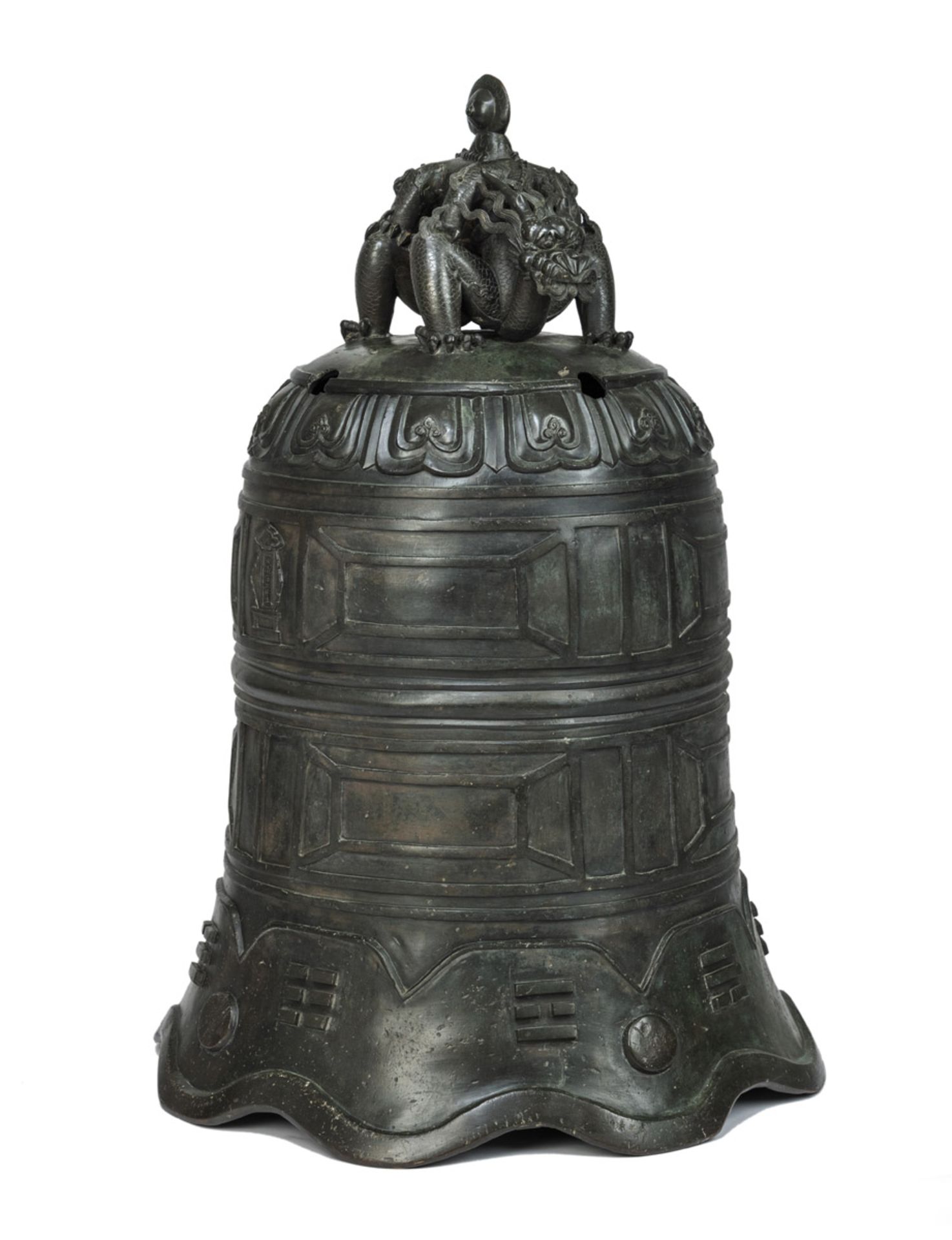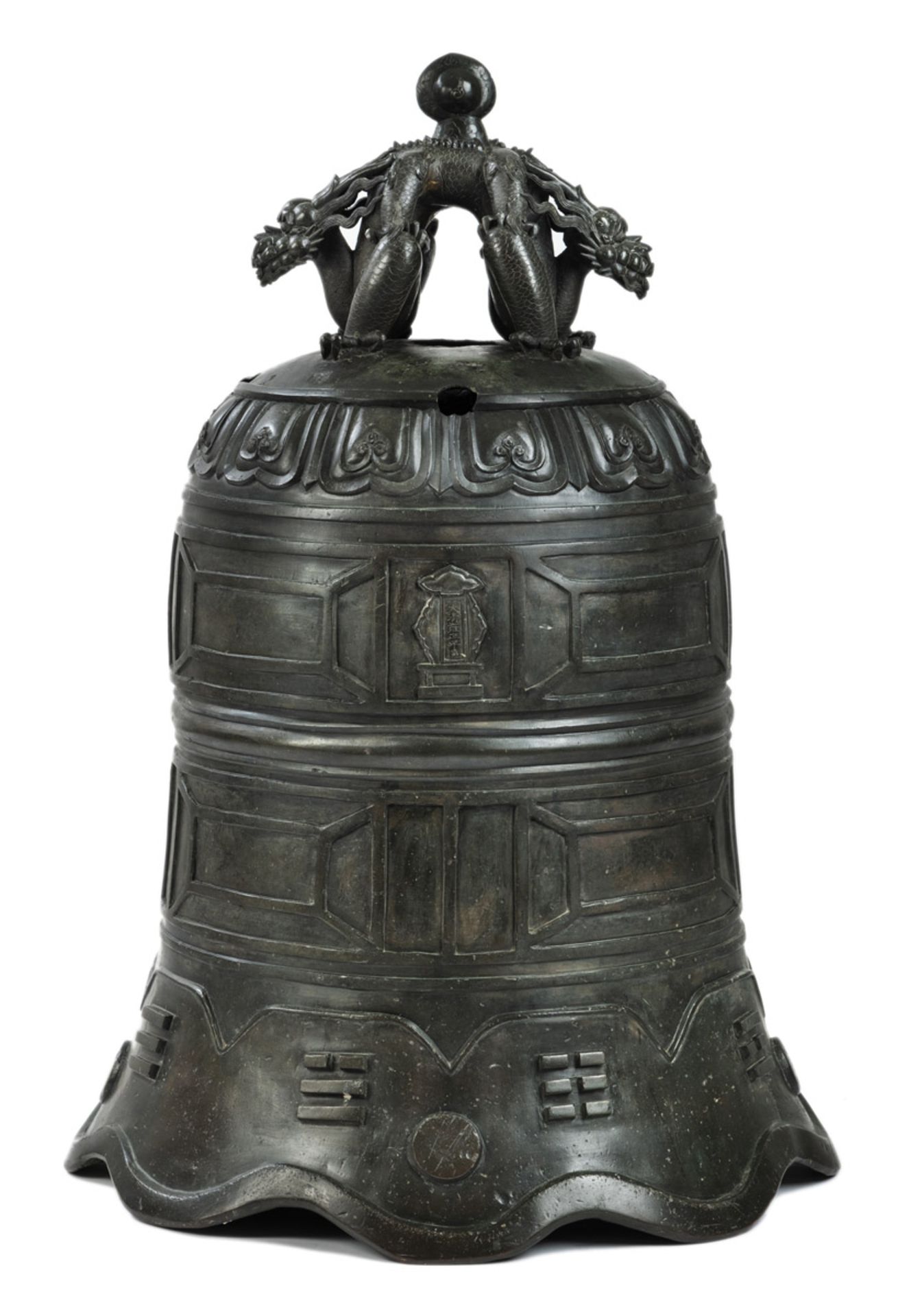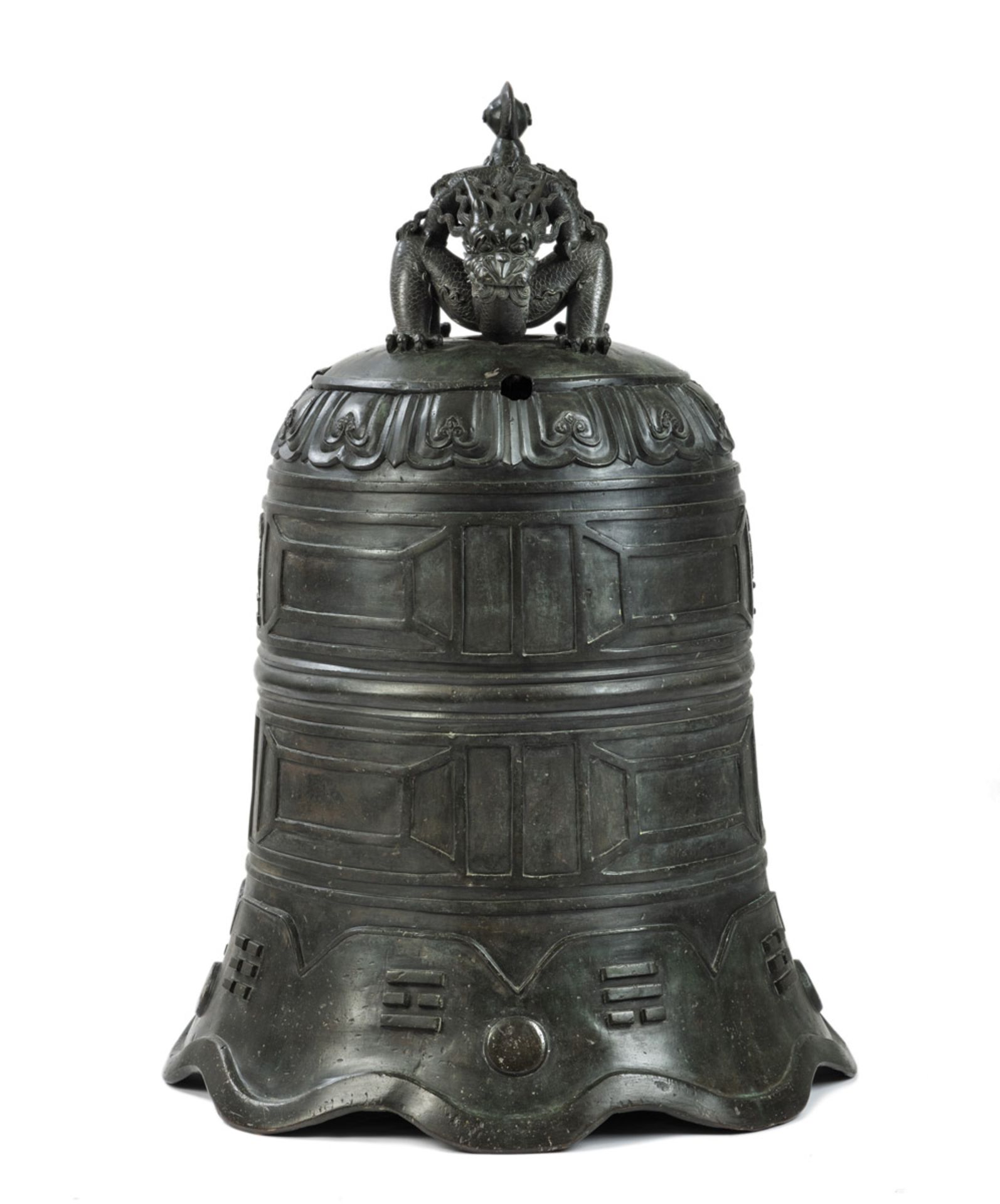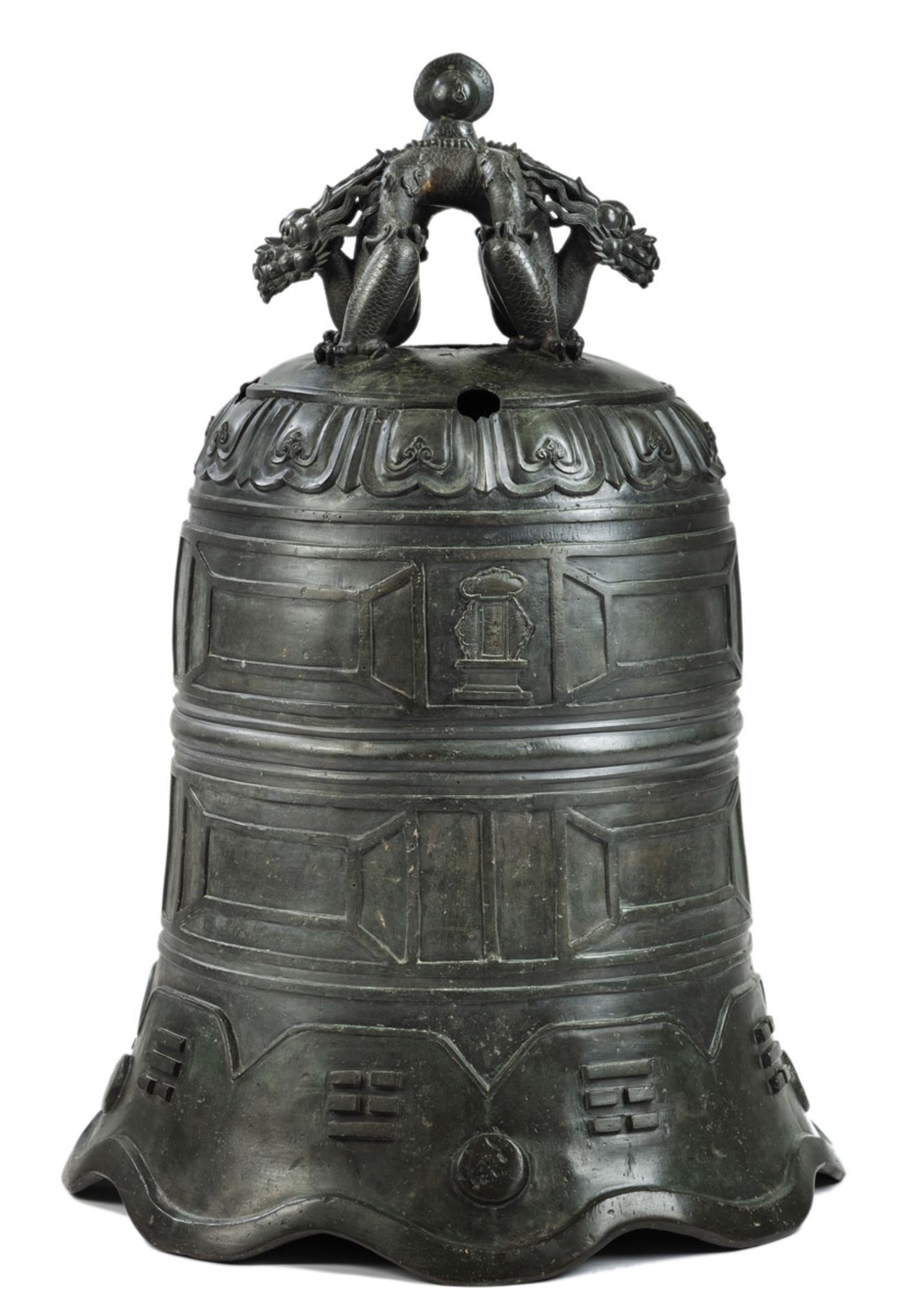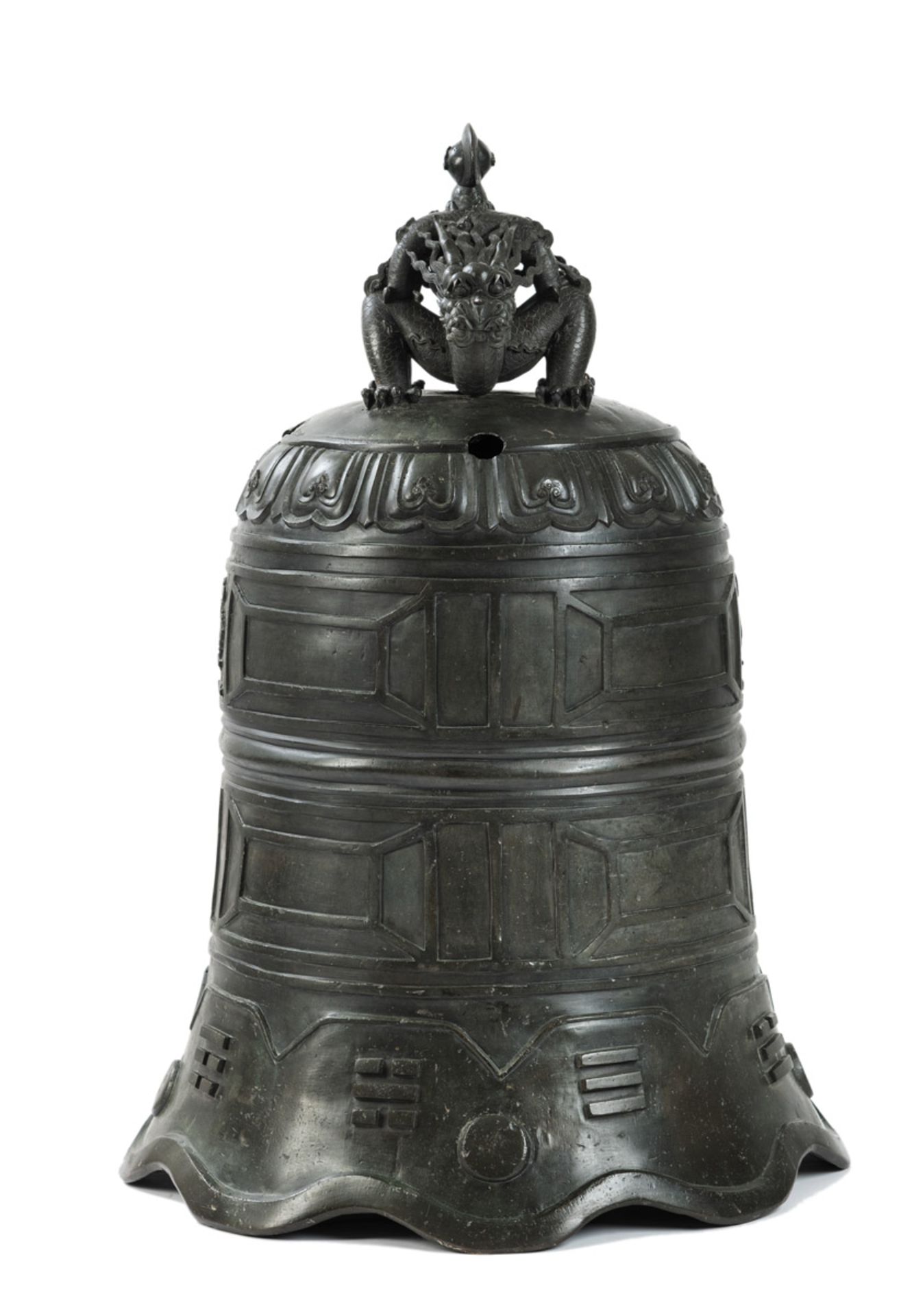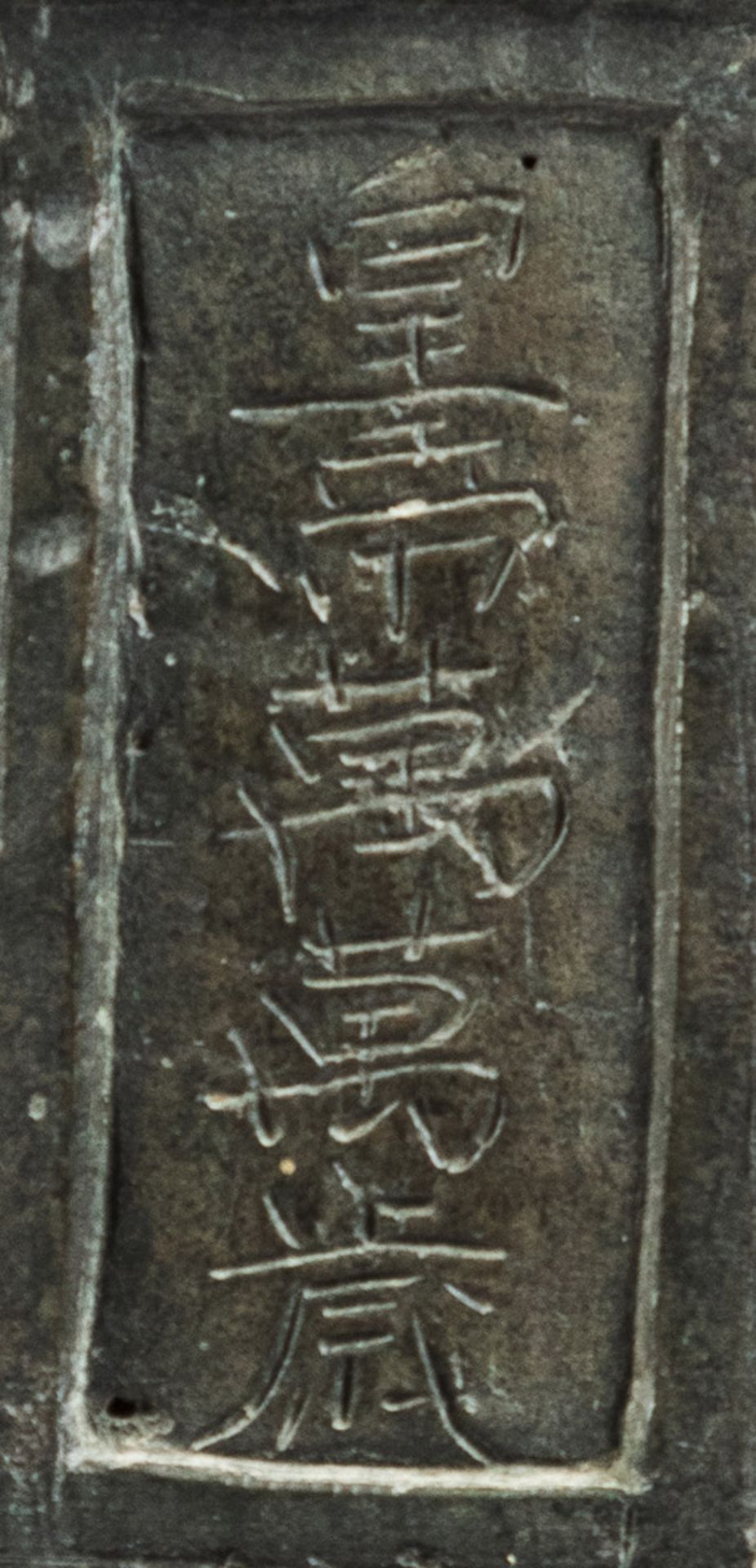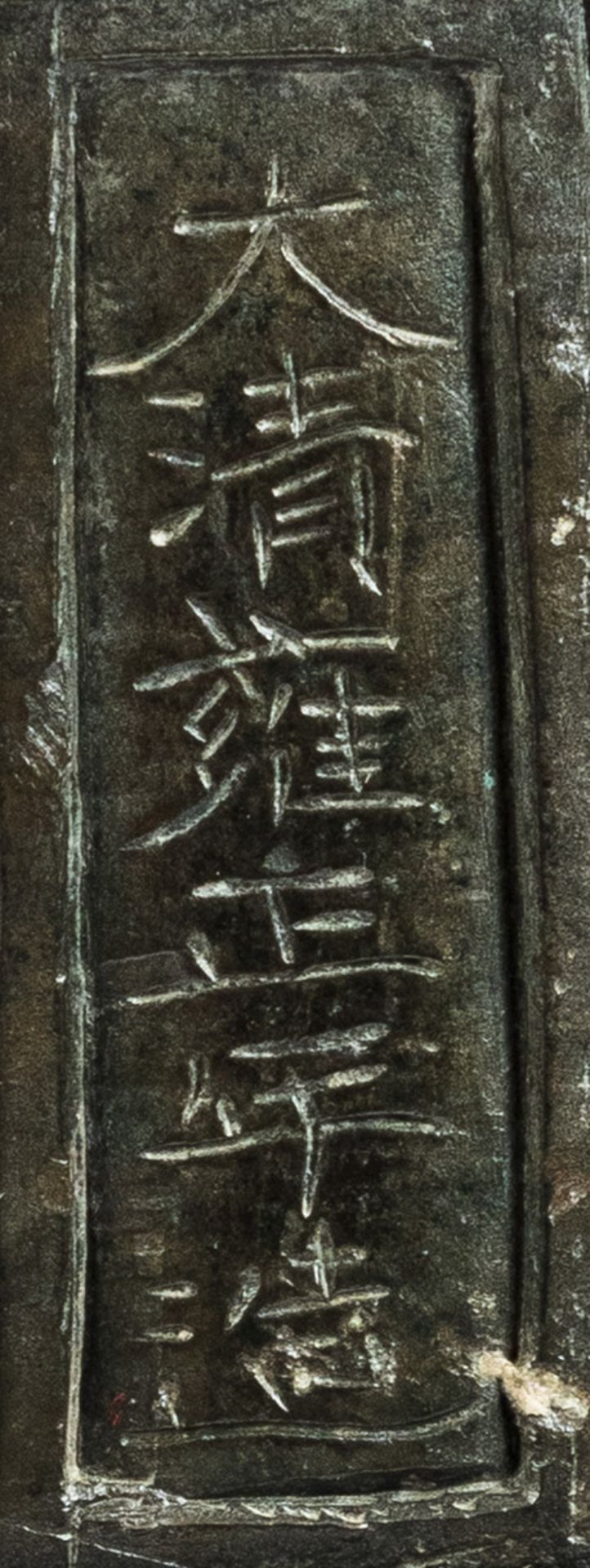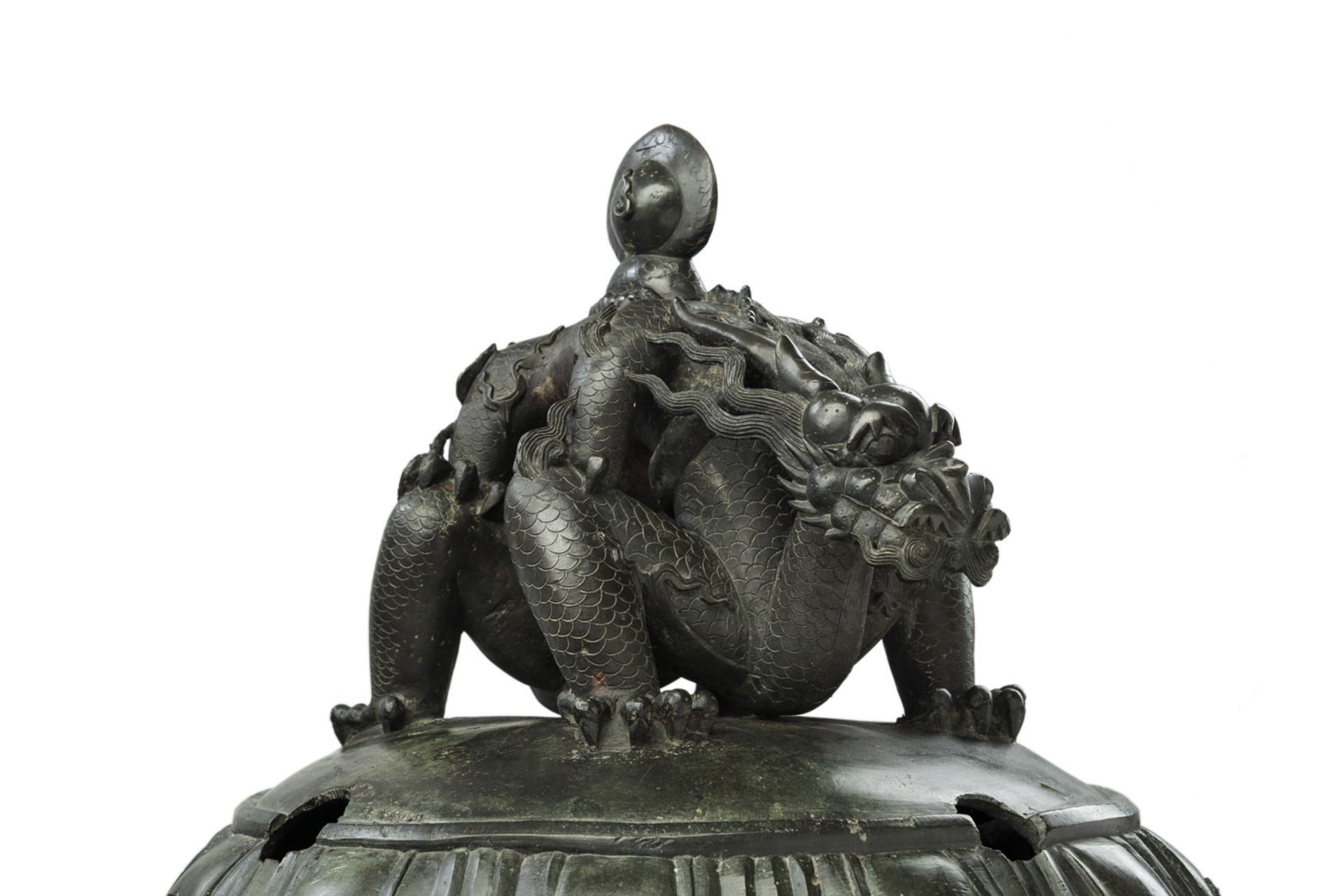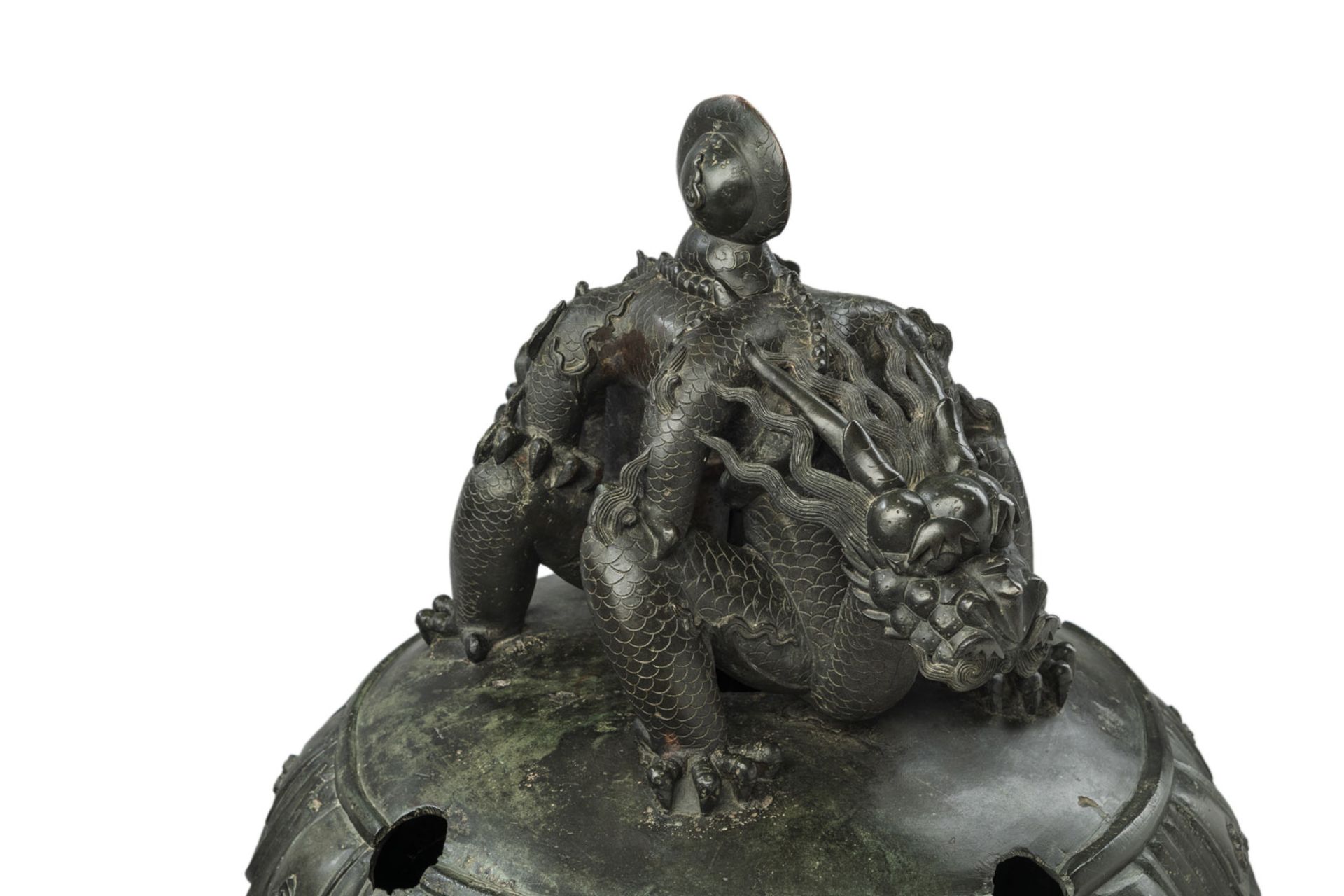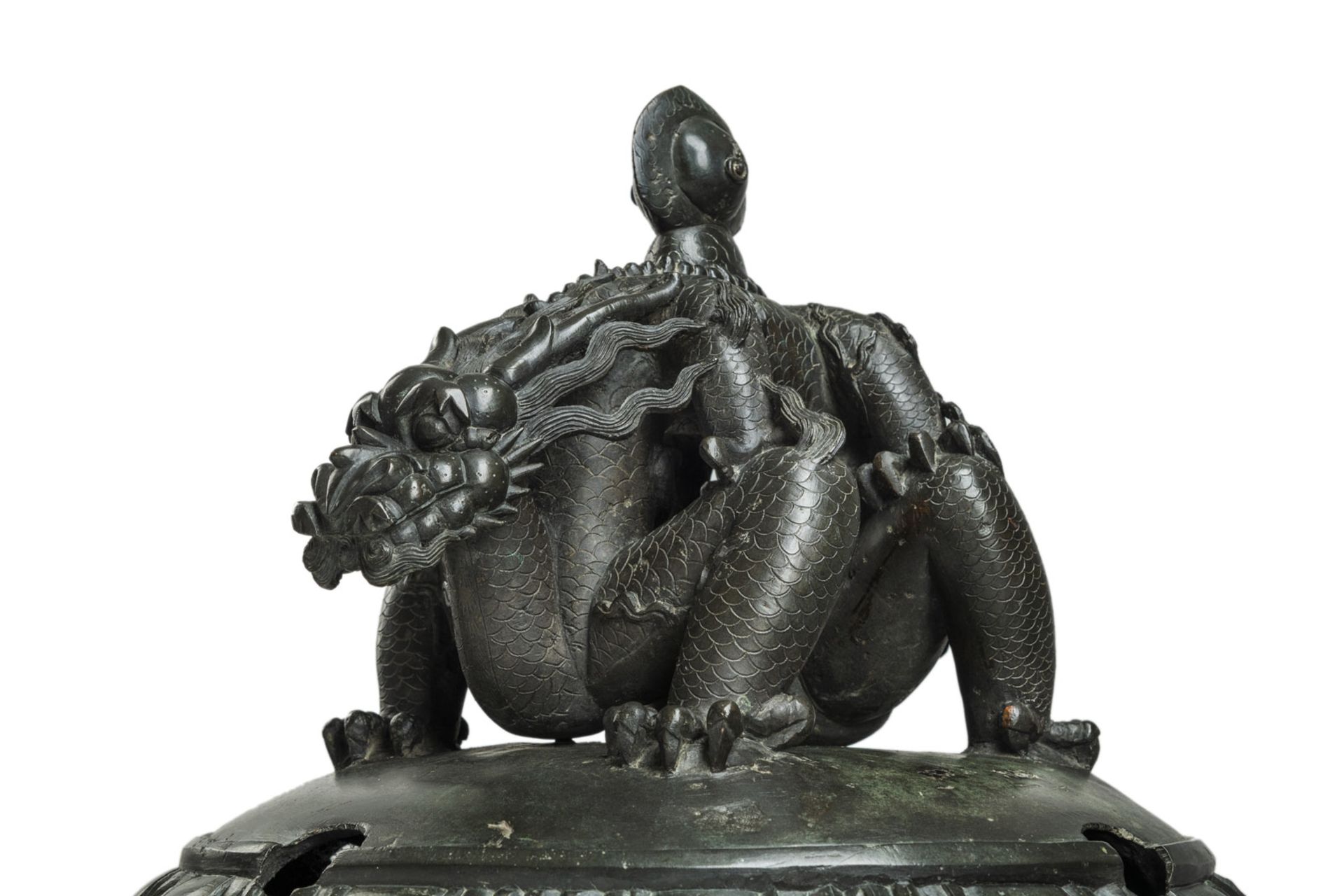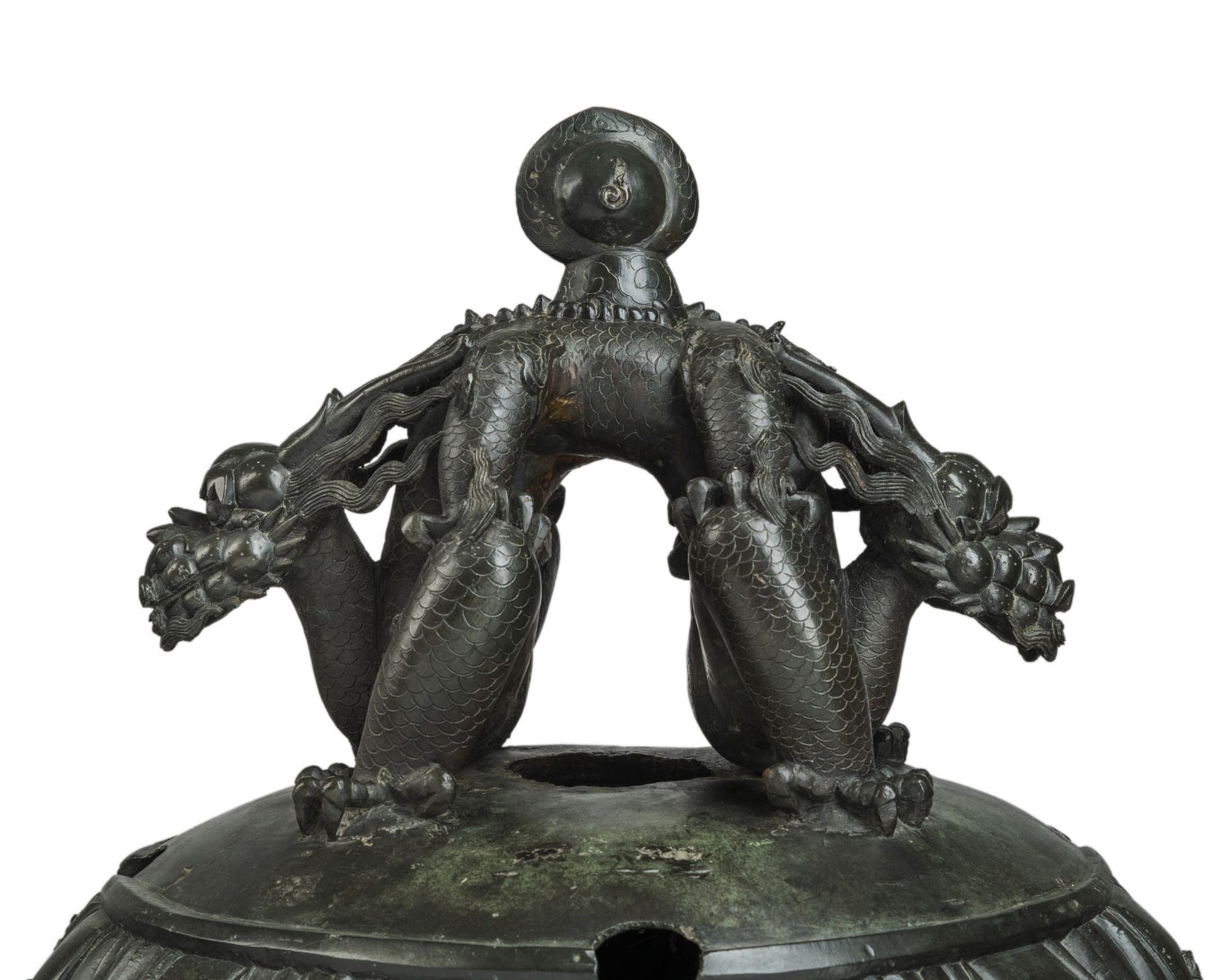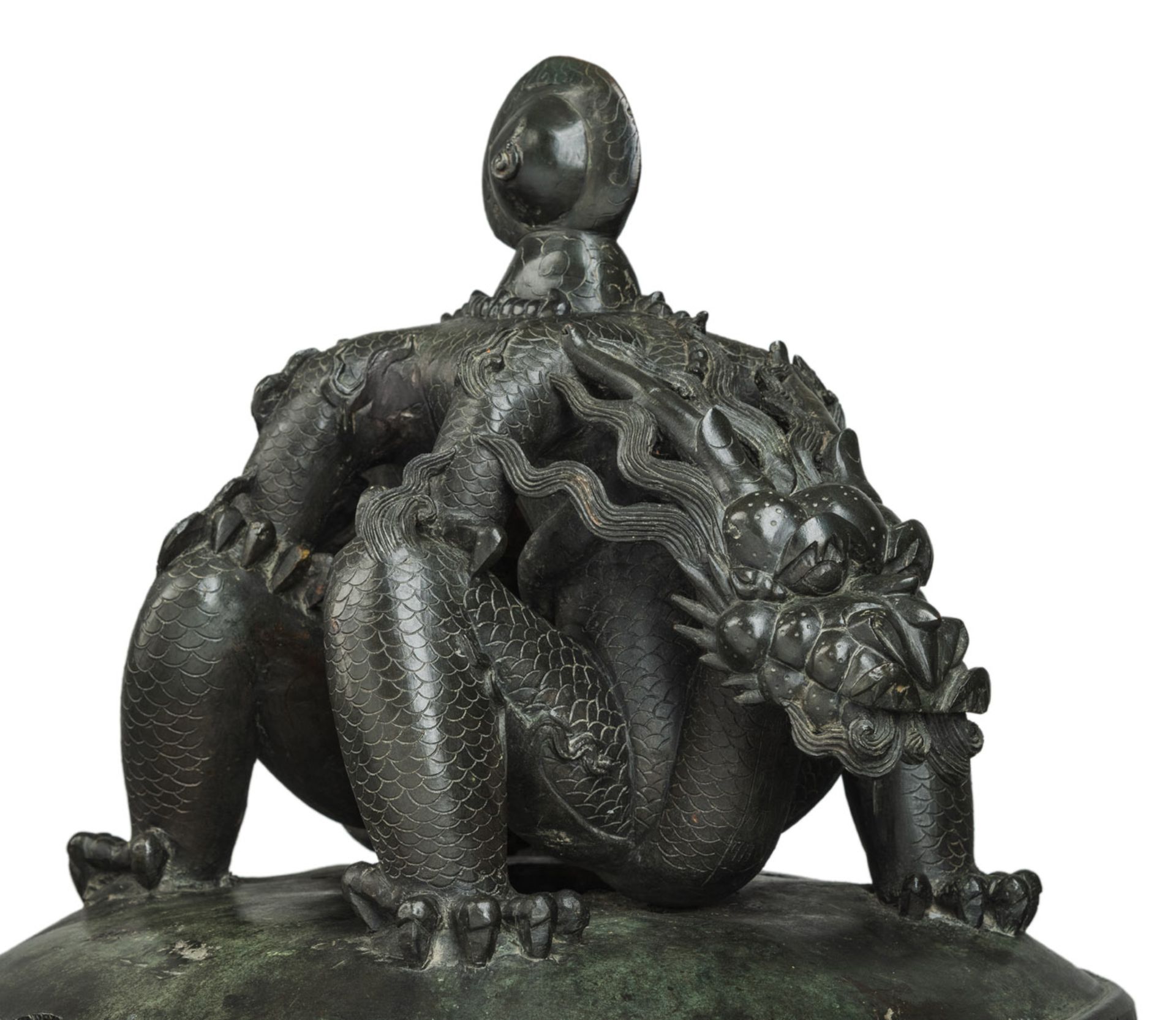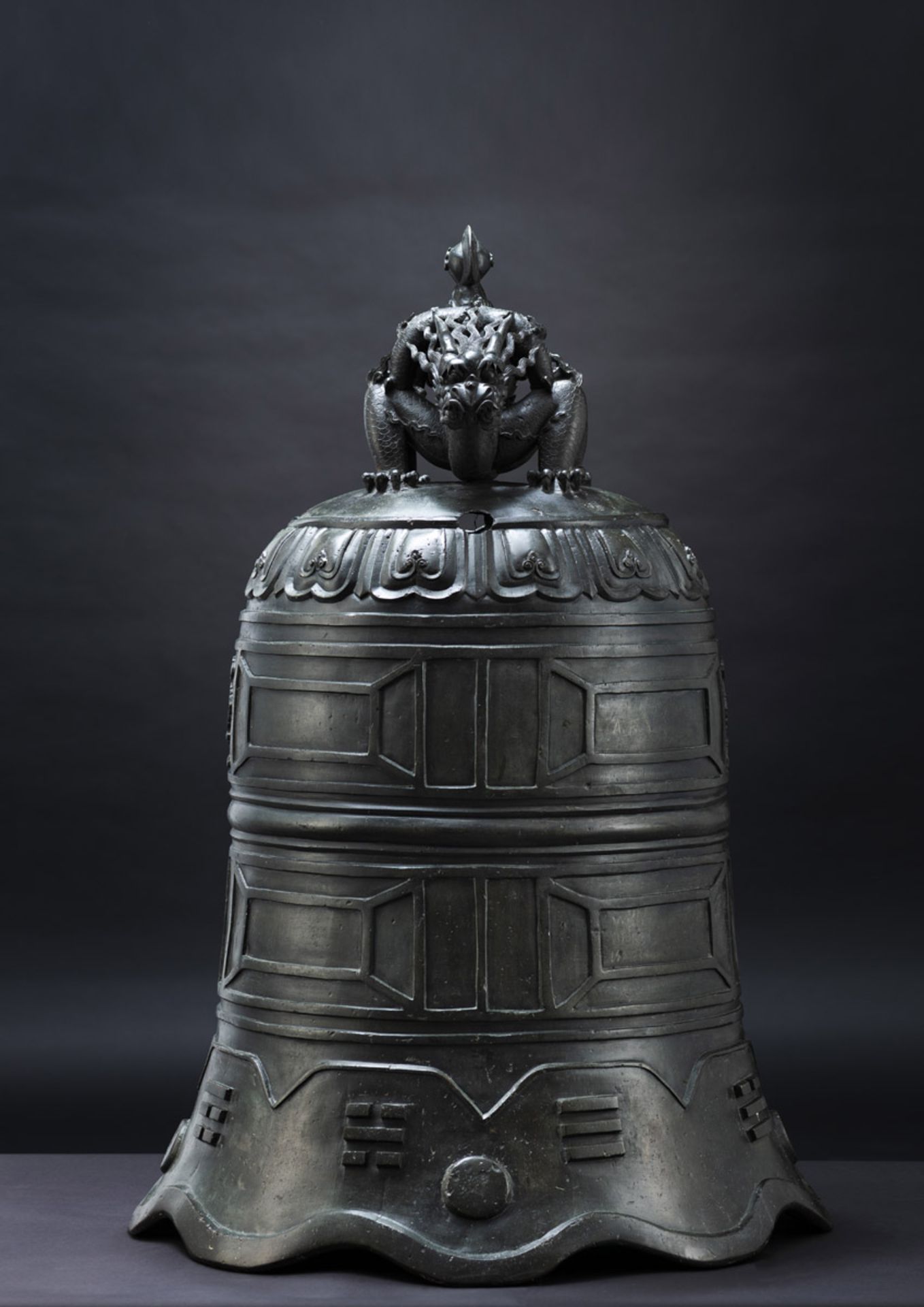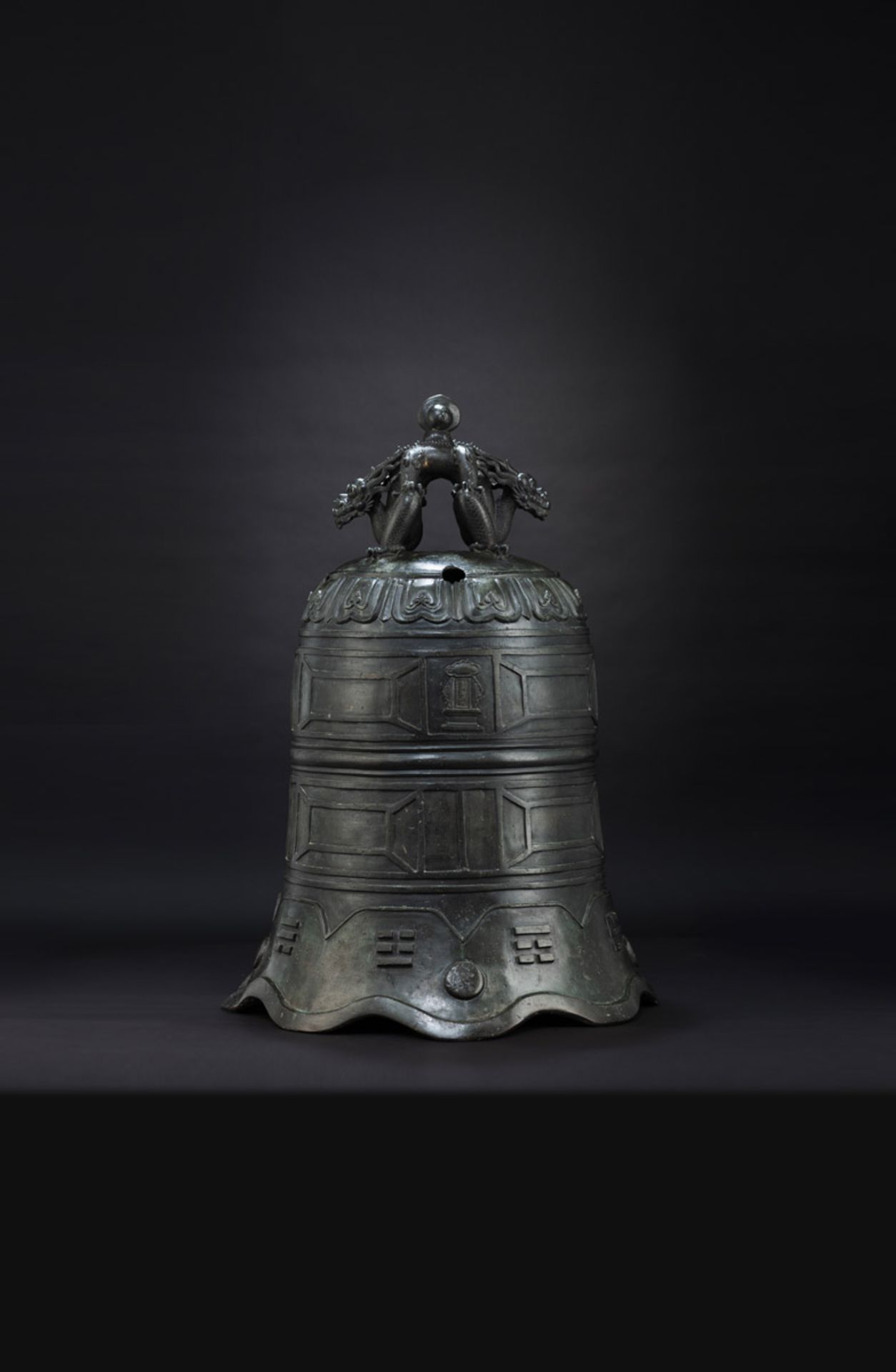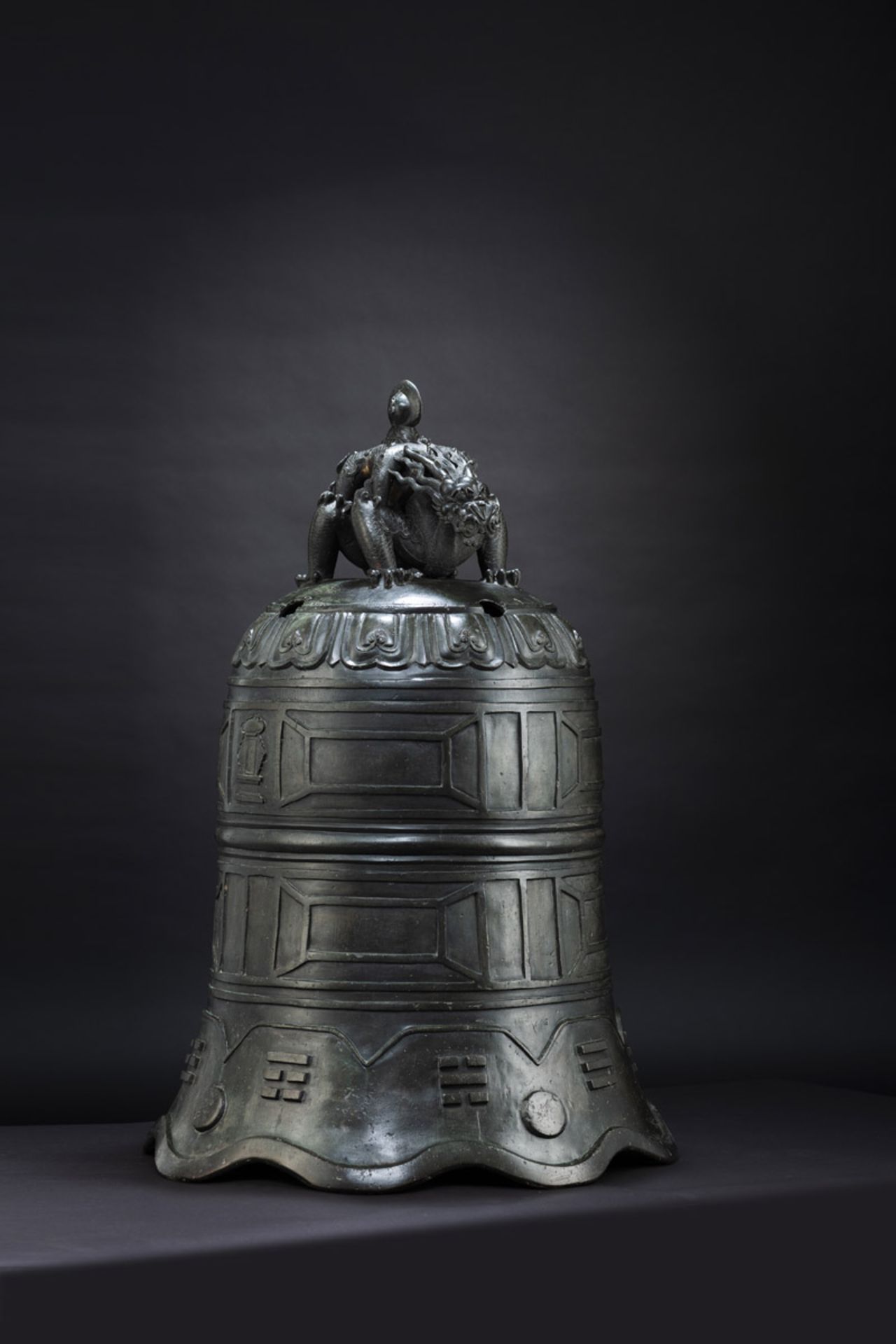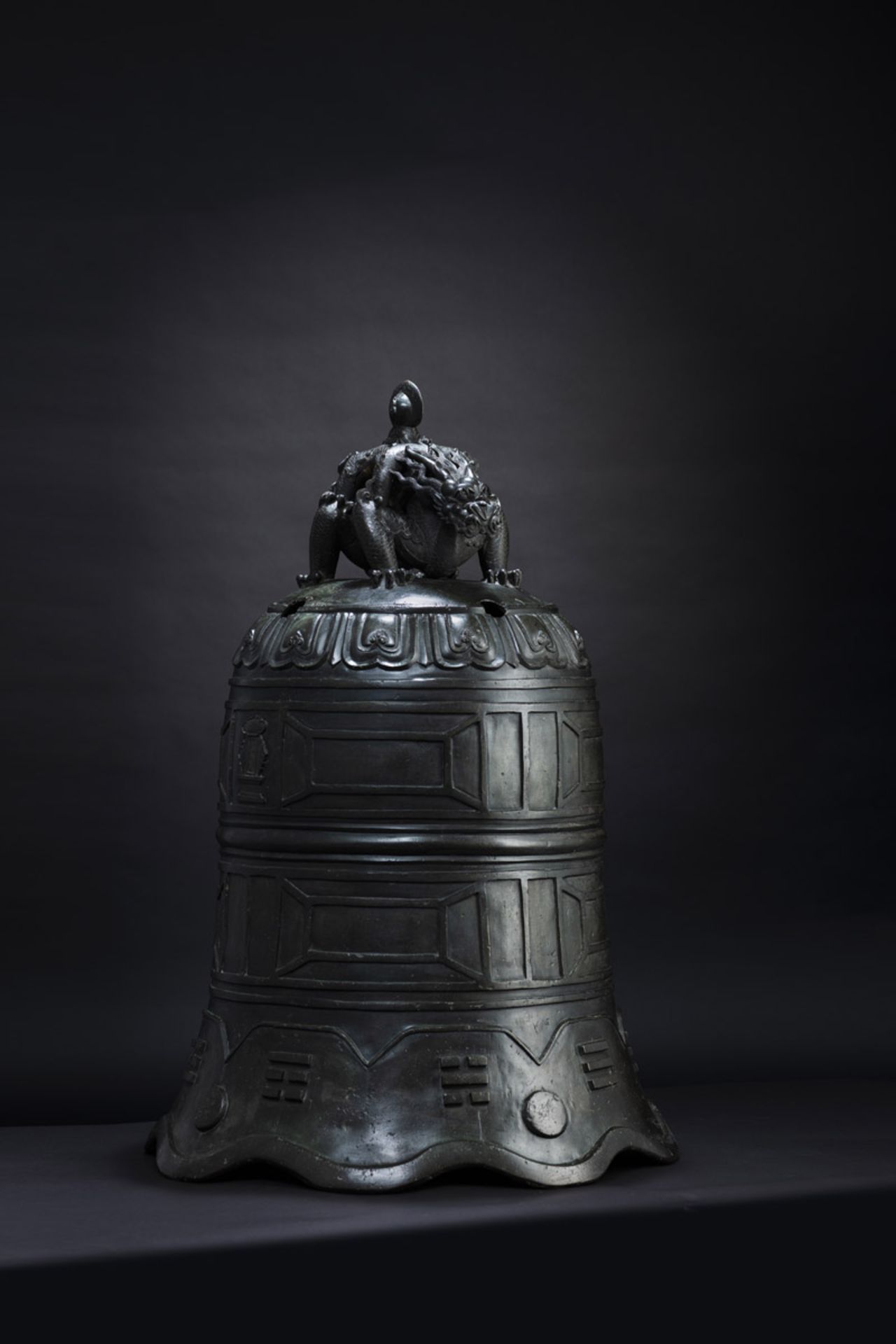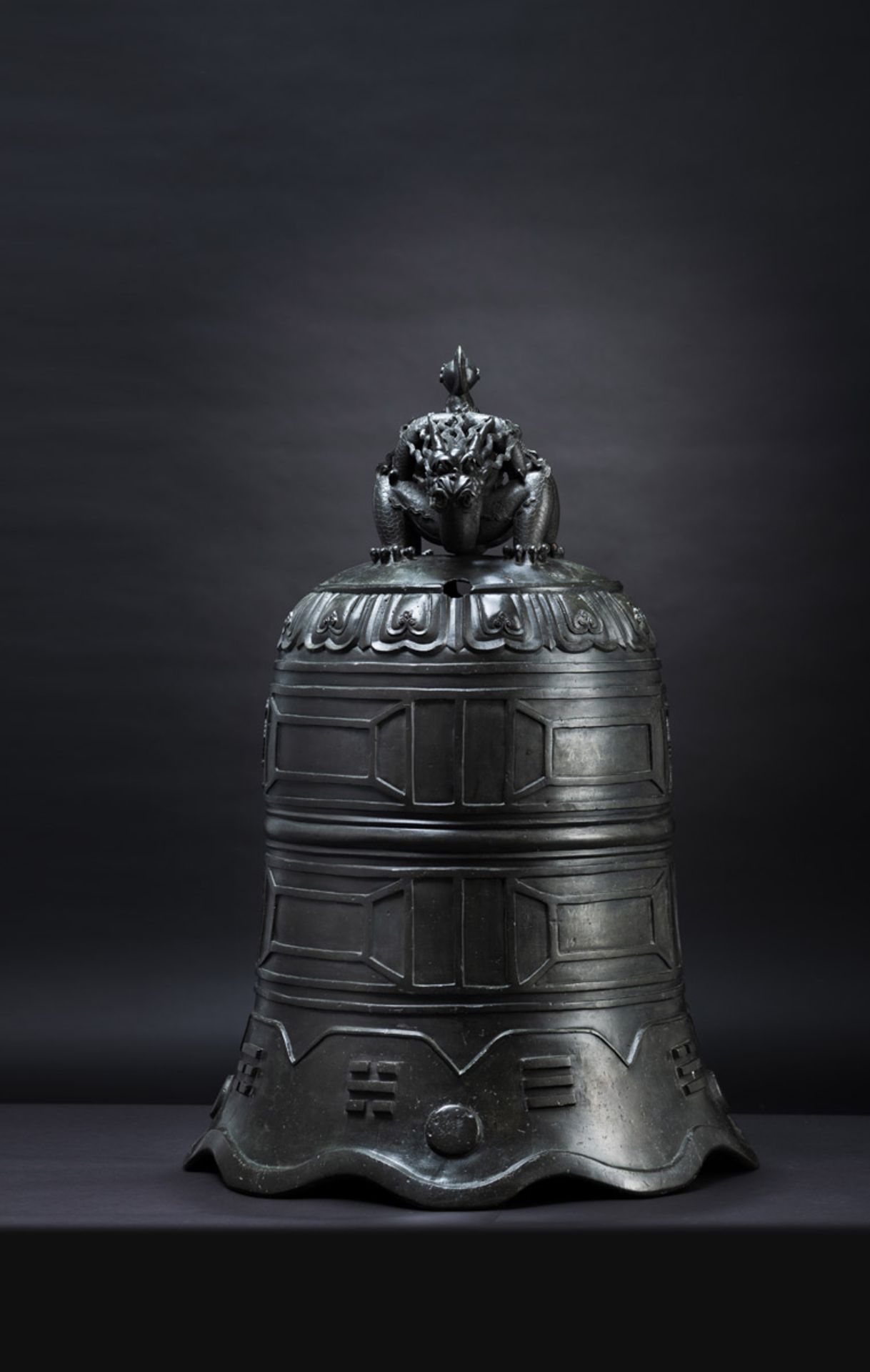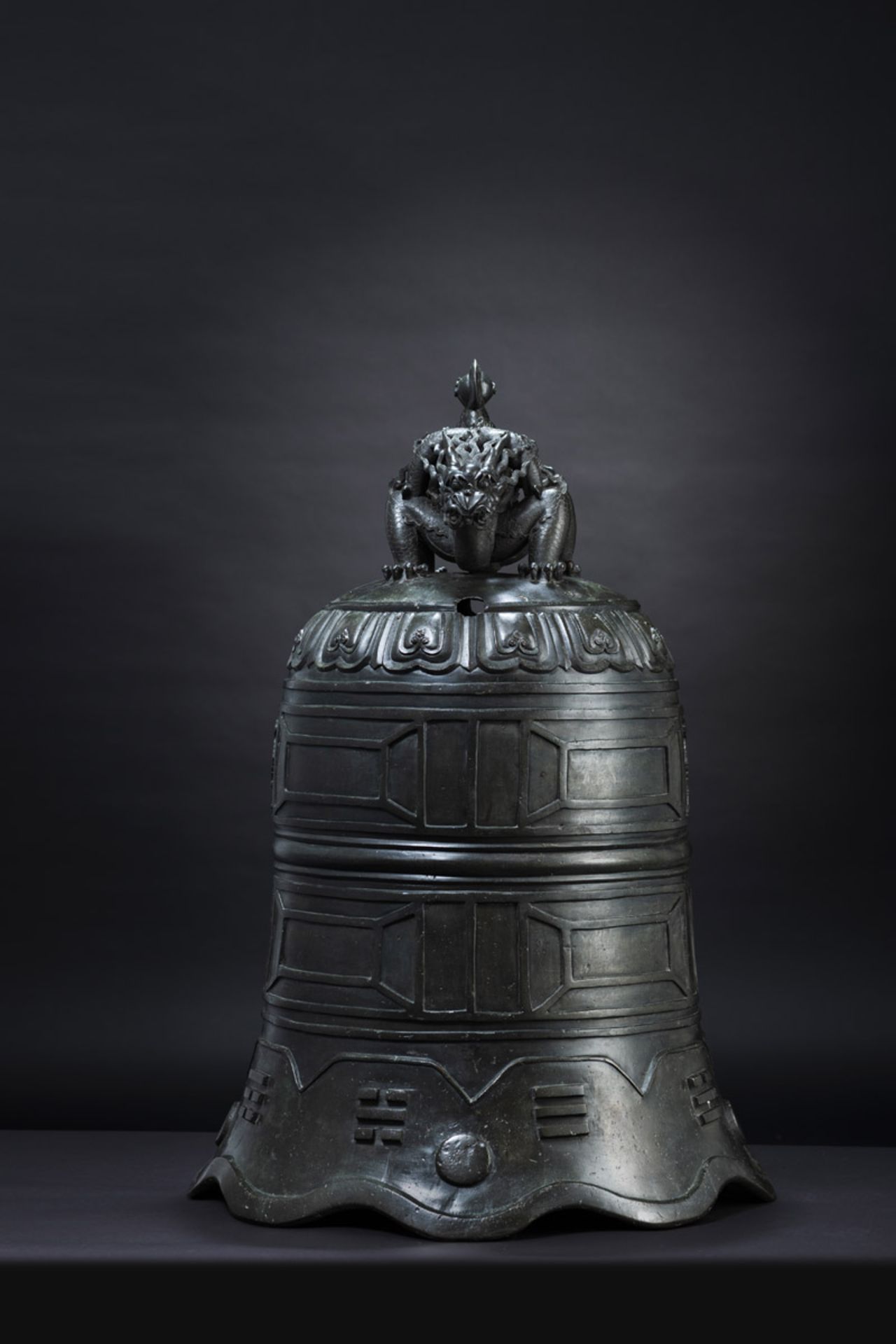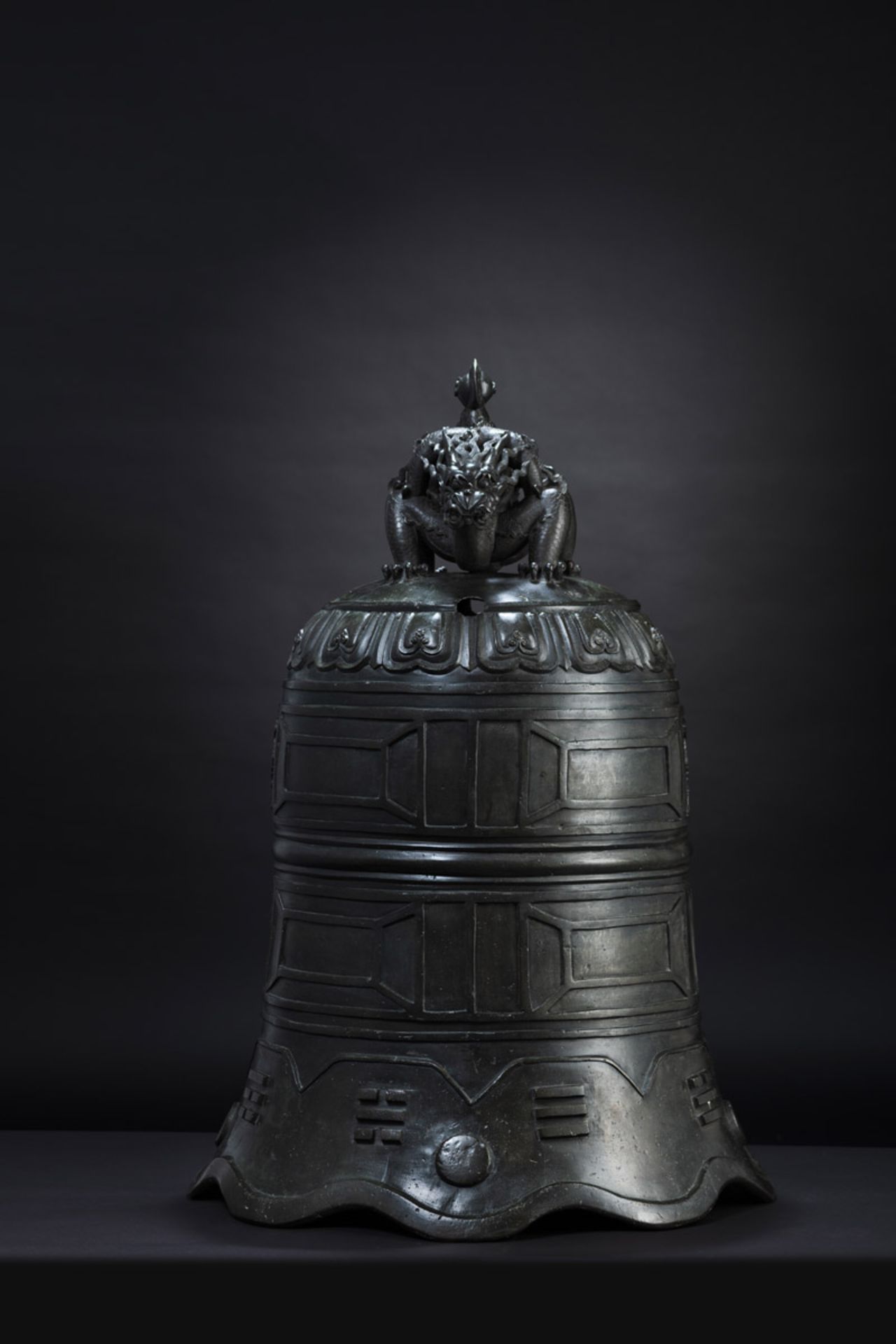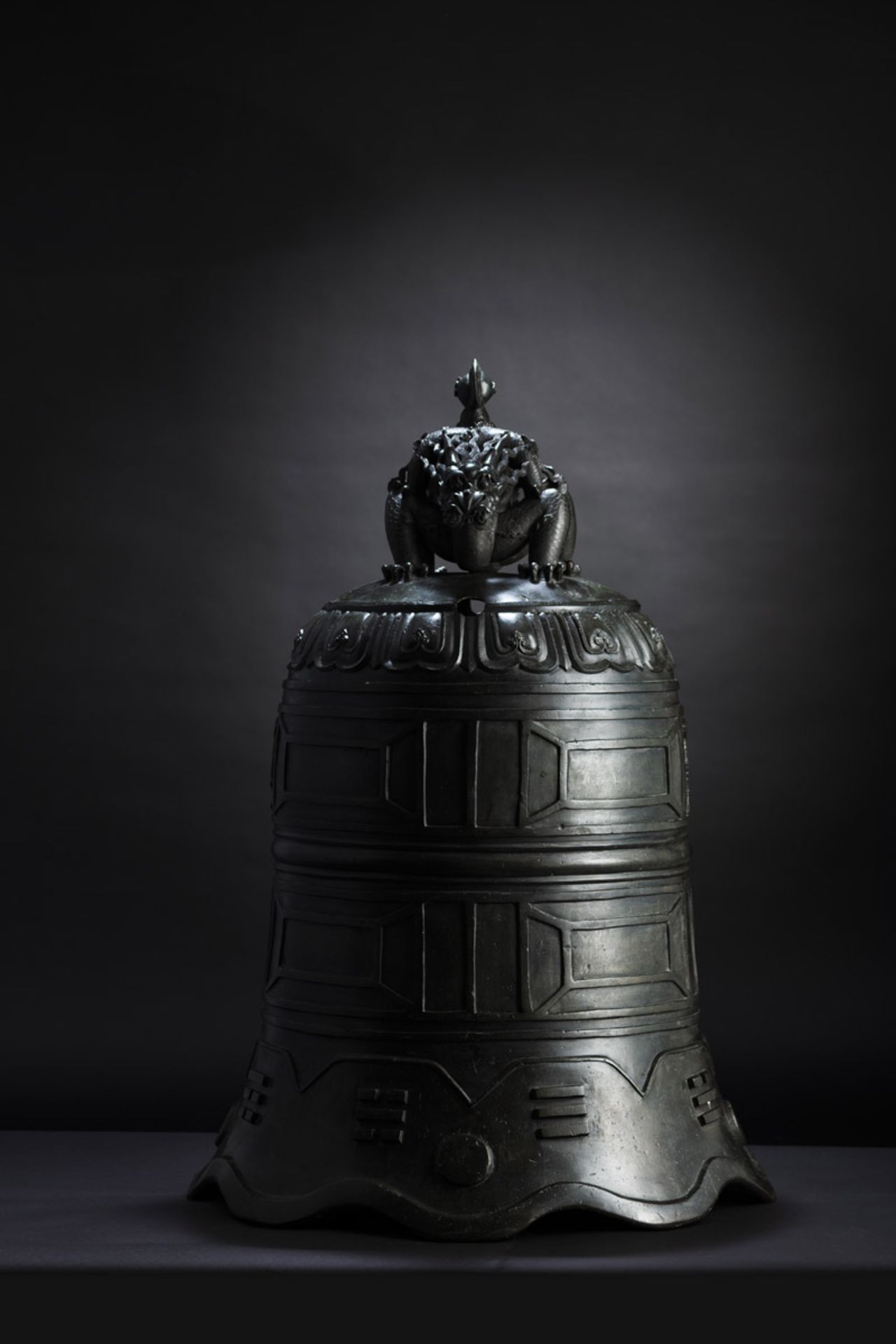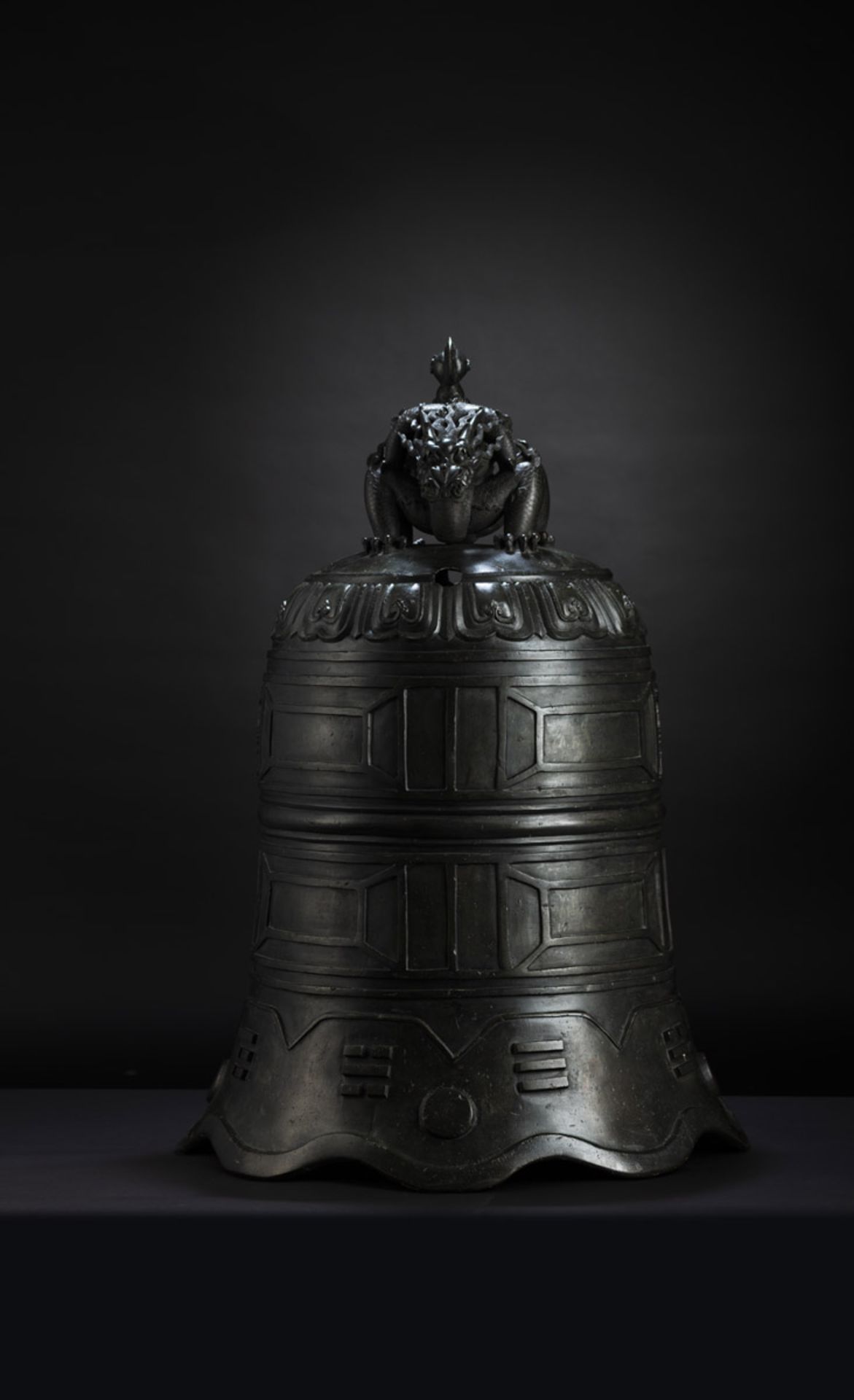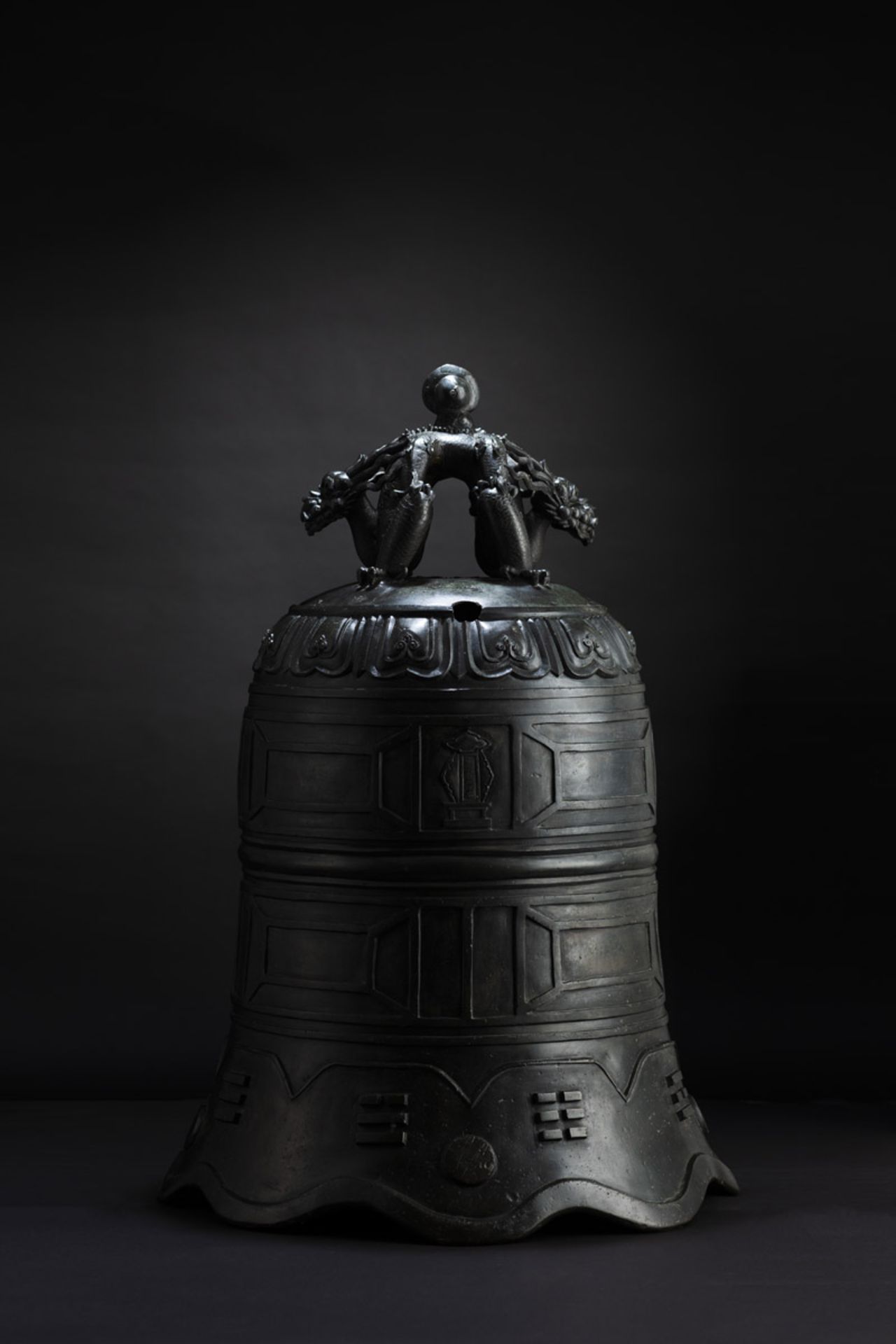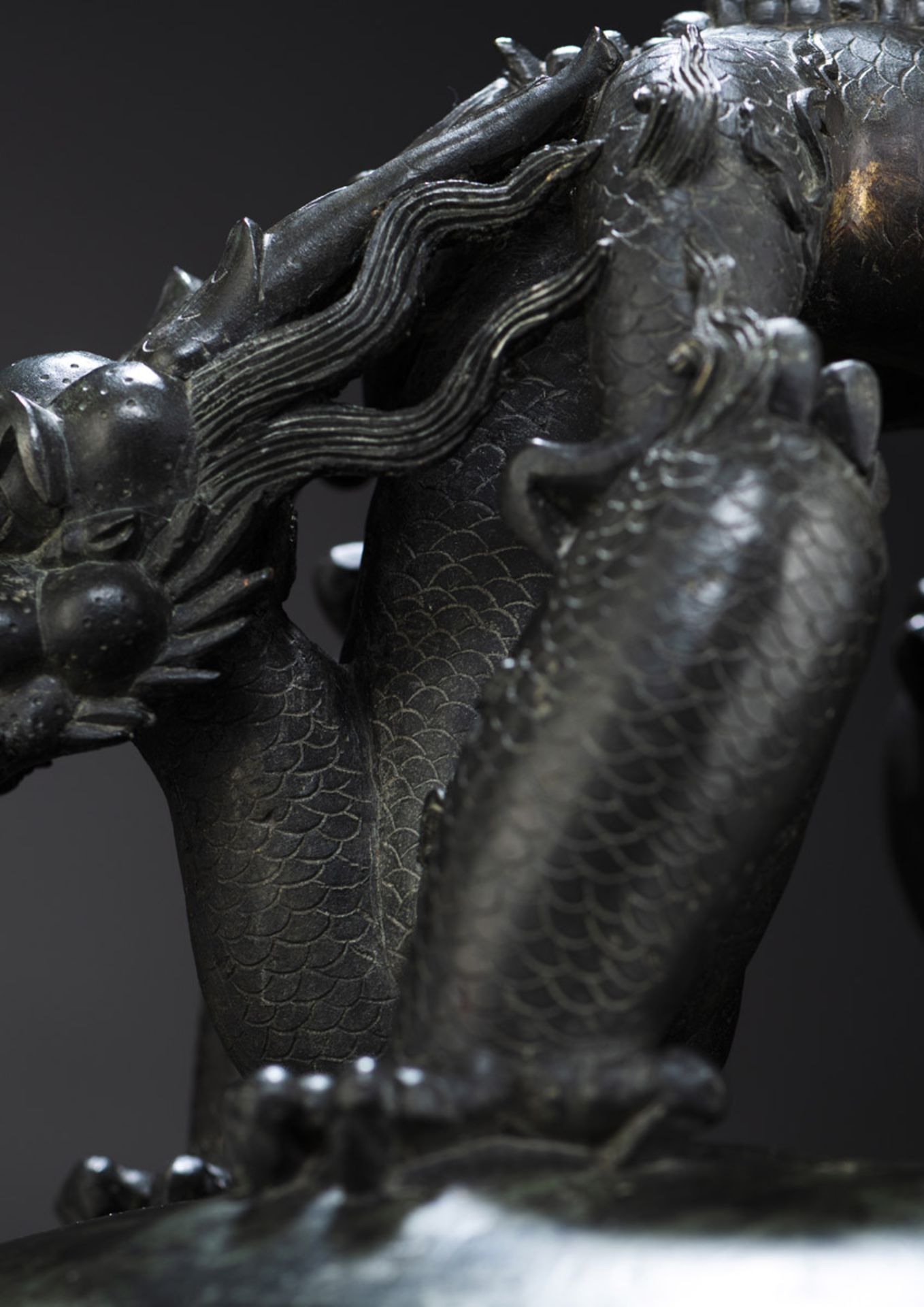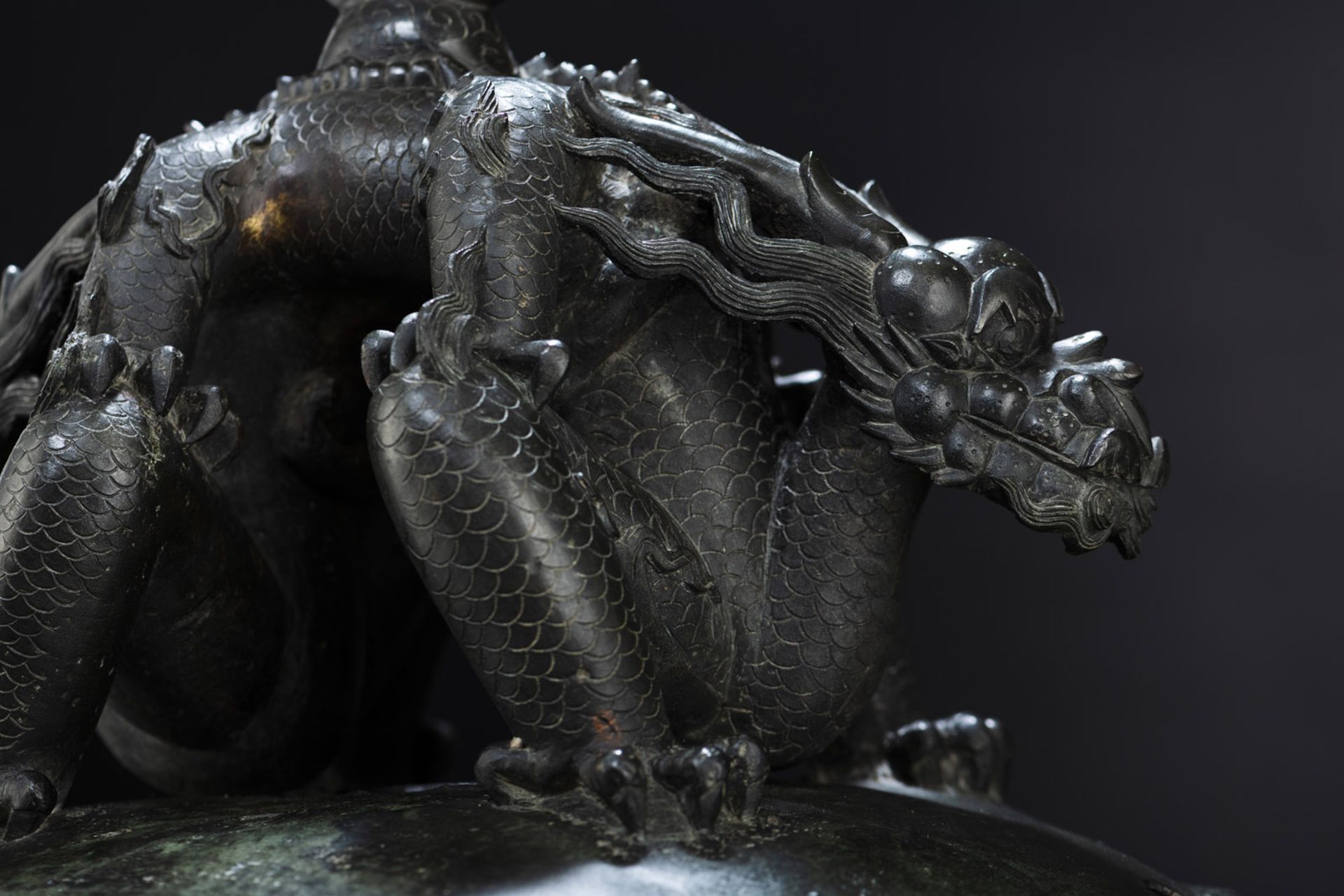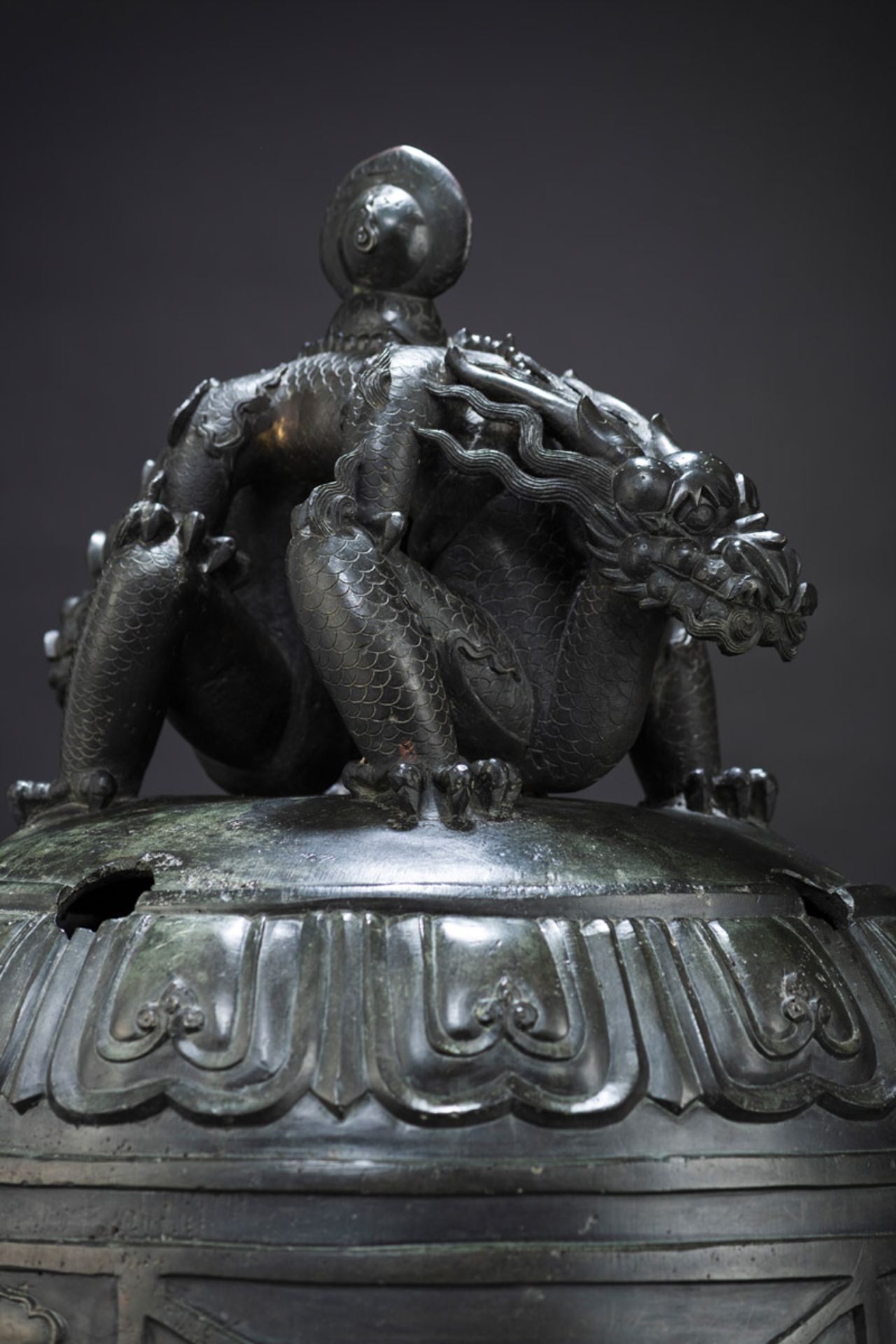8
A VERY RARE AND IMPORTANT LARGE BRONZE BELL
In Asian Art
China, Yongzheng mark and period
H. 106 cm
Bronze with beautiful dark patina. Circumferential decoration of lotus leaves on the shoulder and bagua, the Chinese eight trigrams in the lower third of the sound body. On the front in a reserve in the form of a ritual tablet inscription: huangdi wanwansui (to the long life of the emperor) and on the opposite side a reserve in the form of a ritual tablet with inscription Daqing yongzheng nian zao (made in the Yongzheng period), further down four striking discs in the shape of a full moon flank the four cardinal points. Large suspension in the form of a handle of excellent workmanship in double moulding of the dragon's son Pulao (one of the sons of the dragon in Chinese mythology) and a ratna-shaped pommel in the centre on Pulao's back.
Important German aristocratic private collection, assembled in China prior to 1904 and owned by the family since then
Chinese bronze bells show two main types: One is large and its chime has only a frequency and used to be used at specific times such as imperial or official convocation, an alarm, a ritual or to announce the time in the palace, temple or city centre. The second type is small and was used as a musical instrument. The quality of the striking tone of this bell is mainly based on its geometric shape and the metal used. Striking large bells were an important part in the imperial prayer ritual for blessings and rain.
Large bells with trumpet-shaped mouths were particularly popular in the Ming and Qing periods. The wall thickness of the bronze bell with this mouth gradually increases from the top to the bottom, this design differs from the bell form from Tang times, which usually had flat mouths and a wall of uniform thickness. The more developed design from the Ming period onwards obviously also improved the quality and stability of the large bronze bells, thus avoiding cracks that occurred after long periods of striking. In the 8th chapter yezhu (Metallurgy and Casting) of the Chinese scientific and technical encyclopaedia tiangong kaiwu (The Utilisation of Natural Resources) by Song Yingxing (1587-ca.1666) , published in 1637, one can find the knowledge and experience regarding the casting of large bronze bells in the Ming period with illustrations. It mentions that bronze was the necessary material to make a good bell. chaozhong (large bells for summoning in the courtyard or city centre) in the Ming period were made only of a bronze alloy of bronze, tin, gold and silver and are provided with a handle for hanging in the shape of pulao, the body of the bell was made by casting the multi-part moulds of clay stone together, the decoration on the surface and sometimes also on the inner surface was made by a lost wax process.
The shape and decoration of the bell here is comparable to a large bronze bell , dated 1546 from the Jiajing period in the Mohean Buddhist temple in Beijing. Large bronze bells in Buddhist temples are called fan-zhong (Buddhist bells) and are a typical phenomenon in Chinese Buddhism, because in fact bells were never used in Hindu or Buddhist temples in pre-modern India. The Chinese large bell with the striking tone as a sign has already been described in the historical archives of the Han period. Buddhism as a foreign religion in classical China had not only used this Chinese bell as a temple bell but also adopted the typical Chinese traditional symbols bagua (Eight Trigrams) from the book zhouli (Rites of the Zhou Dynasty). The use of bells in the Buddhist temple was also related to the Confucian view that "The nobleman shows his will and mind through the sounds of the bell and drum". The present bell shows just this interesting phenomenon of cultural integration in classical China.
It is equally worth noting that the imperial manufacture of large bells from the Yongle period of the Ming era onwards was regarded as a symbol of achievement and contribution to the country: gongdazhe zhongda (Man who possesses great achievements can have large bells made.) Also in the Yongle period, the largest known Chinese bronze bell was made, it was 6.75 m high. In 1733, Emperor Yongzheng issued his order to build a Buddhist temple as an imperial temple in Beijing. In 1734, Emperor Yongzheng gave the name Jueshengsi to this temple. In 1743, the Great Yongle Bell was placed in Jueshengsi Temple by order of Emperor Qianlong. By the end of the Qing period, Jueshengsi Temple became one of the most important places for the imperial prayer ritual around rain. In the archives of the Yongzheng period by the court office zaobanchu (imperial workshop), various bronze bells chaozhong for summoning in the courtyard and baozhong (bell for time announcement, usually smaller than chaozhong but also often with a height of more than one metre) in the courtyard were made, for example in the imperial order on the 5th day of the chin. 8th month in the 8th year of the Yongzheng period (1730) records the order of a bronze bell baozhong for use in Buddhist ritual in court, and according to the archives of zaobanchu, this baozhong was finished being made on the 20th day of the Chin. 9th year of the Yongzheng period (1731) and finished being added to the Buddhist hall in the palace. The imperial order on the 12th day of the chin. 3rd month in the 9th year of the Yongzheng period (1731) records the order of a bronze chaozhong bell for use in Taoist ritual in court, and according to the zaobanchu archive, this chaozhong was finished in the chin. leap month of the 10th year of the Yongzheng period (1732) and delivered to the hall for religious ritual in Yonghegong Palace.
Traces of age, four later drilled holes on the shoulder
China, Yongzheng-Marke und Periode
H. 106 cm
Bronze mit schöner dunkler Patina. Umlaufender Dekor von Lotusblättern auf der Schulter und bagua, den chinesischen Acht Trigrammen im unteren Drittel des Klangkörpers. Auf der Front in einer Reserve in Form einer Ritualtafel Inschrift: huangdi wanwansui (zum langen Leben vom Kaiser) und auf der Gegenseite eine Reserve in Form einer Ritualtafel mit Inschrift Daqing yongzheng nian zao (hergestellt in der Yongzheng Periode), weiter unten flankieren vier Schlagscheiben in Vollmond-Form die vier Himmelsrichtungen. Große Aufhängung in Form eines Griffes in exzellenter Ausführung in doppelter Ausformung des Drachensohns Pulao (einem der Söhne des Drachen in chin. Mythologie) und einem Ratna-förmigen Knauf in der Mitte auf dem Rücken von Pulao.
Aus bedeutendem aristokratischen Besitz, vor 1904 in China gesammelt und seither in Deutschland durch Erbschaft durchgehend in derselben Familie
Chinesische Bronzeglocken zeigen zwei Haupttypen: Eine ist groß und ihr Schlagton ist lediglich mit einer Frequenz versehen und wurde früher zu bestimmten Zeiten wie z. B. beim kaiserlichen oder offiziellen Einberufen, einem Alarm, einem Ritual oder bei einer Zeitansage im Palast, dem Tempel oder der Stadtmitte verwendet. Der zweite Typ ist klein und wurde als Musikinstrument verwendet. Die Qualität des Schlagtones dieser Glocke beruht hauptsächlich auf ihrer geometrischen Form und dem verwendeten Metall. Große Glocke zu schlagen war ein wichtiger Teil im kaiserlichen Gebetsritual um Segen und Regen.
Große Glocken mit trompetenförmigen Mündungen waren in der Ming- und Qing-Zeit besonders beliebt. Die Wandungsdicke der Bronzeglocke mit dieser Mündung nimmt allmählich von oben nach unten zu, dieser Entwurf unterscheidet sich dadurch von der Glockenform aus Tang- Zeit, welche normalerweise flache Mündungen und eine Wandung mit gleichmäßiger Dicke hatten. Der weiter entwickelte Entwurf ab der Ming-Zeit verbesserte offensichtlich auch die Qualität und die Stabilität der großen Bronzeglocken, es wurden so Risse, die sich nach langen Schlagzeiten einstellten, vermieden. Im 8. Kapitel yezhu (Metallurgie und Gießen) der chinesischen naturwissenschaftlich-technischen Enzyklopädie tiangong kaiwu (Die Nutzung der natürlichen Vorkommen) von Song Yingxing (1587-ca.1666) , publiziert 1637 kann man das Wissen und die Erfahrungen im Bezug auf das Gießen der großen Glocken aus Bronze in der Ming-Zeit mit Illustrationen finden. Darin ist erwähnt, dass Bronze das erforderliche Material zur Herstellung von einer guten Glocke war. chaozhong (Große Glocken für das Einberufen im Hof oder der Stadtmitte) wurden in der Ming-Zeit nur aus einer Bronzelegierung aus Bronze, Zinn, Gold und Silber hegestellt und sind mit einem Griff zum Aufhängen in Gestalt von Pulao versehen, der Korpus der Glocke wurde durch die mehrteiligen Gussformen aus Tongestein zusammen angefertigt, der Dekor auf der Oberfläche und manchmal auch auf der Innerfläche entstand durch ein Wachsausschmelzverfahren.
Die Form und der Dekor der hier vorliegenden Glocke ist vergleichbar mit einer großen Bronzeglocke , datiert 1546 aus der Jiajing-Periode im buddhistischen Tempel Mohean in Beijing. Große Bronzeglocken in buddhistischen Tempeln werden als fan-zhong (Buddhistische Glocken) genannt und sind ein typisches Phänomen im chinesischen Buddhismus, denn in der Tat wurden nie Glocken in hinduistischen oder buddhistischen Tempeln im vormodernen Indien verwendet. Die chinesische große Glocke mit dem Schlagton als Zeichen wurde bereits in den historischen Archiven der Han-Zeit beschrieben. Der Buddhismus als eine fremde Religion im klassischen China hatte nicht nur diese chinesische Glocke als Tempelglocke verwendet sondern auch die typisch chinesischen traditionellen Symbolen bagua (Acht Trigrammen) aus dem Buch zhouli (Riten der Zhou Dynastie) übernommen. Die Verwendung von Glocken im buddhistischen Tempel war auch im Zusammenhang mit der konfuzianischen Ansicht, dass "Der Edelmann zeigt seinen Willen und Verstand durch die Töne der Glocke und Trommel". Die vorliegenden Glocke zeigt gerade dieses interessante Phänomen der kulturellen Integration im klassischen China.
Es ist ebenso erwähnenswert, dass die kaiserliche Herstellung der großen Glocken ab der Yongle-Periode der Ming-Zeit als ein Symbol der Leistung und des Beitrages für das Land betrachtet wurde: gongdazhe zhongda (Mensch, der große Leistungen besitzt, kann große Glocken herstellen lassen.) Auch in der Yongle-Periode wurde die größte bekannte chinesische Bronzeglocke hergestellt, sie war 6,75 m hoch. 1733 erteilte Kaiser Yongzheng seinen Befehl, einen buddhistischen Tempel als kaiserlichen Tempel in Peking zu bauen. 1734 vergab Kaiser Yongzheng den Namen Jueshengsi an diesen Tempel. 1743 wurde die große Yongle-Glocke auf Befehl von Kaiser Qianlong im Tempel Jueshengsi platziert. Bis zum Ende der Qing-Zeit wurde der Tempel Jueshengsi einer der wichtigsten Orte für das kaiserliche Gebetsritual um Regen. Im Archiv der Yongzheng-Periode vom Hofamt zaobanchu (Kaiserliche Werkstatt) wurden diverse Bronzeglocken chaozhong für das Einberufen im Hof und baozhong (Glocke für Zeitansage, normalerweise kleiner als chaozhong aber auch häufig mit einer Höhe von mehr als einem Meter) im Hof hergestellt, so zum Beispiel im kaiserlichen Befehl am 5. Tag des chin. 8. Monates im 8. Jahr der Yongzheng Periode (1730) ist die Bestellung eine Bronze Glocke baozhong zur Verwendung im buddhistischen Ritual in Hof verzeichnet und gemäß dem Archiv von zaobanchu wurde diese baozhong am 20. Tag des chin. 9. Jahr der Yongzheng Periode (1731) fertig hergestellt und in der buddhistischen Halle im Palast fertig angebaut. Im kaiserlichen Befehl am 12. Tag des chin. 3. Monates im 9. Jahr der Yongzheng Periode (1731) ist die Bestellung einer Bronzeglocke chaozhong zur Verwendung im taoistischen Ritual in Hof verzeichnet und gemäß dem Archiv von zaobanchu wurde diese chaozhong im chinesischen Schaltmonat des 10. Jahr der Yongzheng Periode (1732) fertig hergestellt und an die Halle für religiöse Ritualen im Palast Yonghegong geliefert.
Altersspuren, vier spätere Bohrungen an der Schulter
China, Yongzheng mark and period
H. 106 cm
Bronze with beautiful dark patina. Circumferential decoration of lotus leaves on the shoulder and bagua, the Chinese eight trigrams in the lower third of the sound body. On the front in a reserve in the form of a ritual tablet inscription: huangdi wanwansui (to the long life of the emperor) and on the opposite side a reserve in the form of a ritual tablet with inscription Daqing yongzheng nian zao (made in the Yongzheng period), further down four striking discs in the shape of a full moon flank the four cardinal points. Large suspension in the form of a handle of excellent workmanship in double moulding of the dragon's son Pulao (one of the sons of the dragon in Chinese mythology) and a ratna-shaped pommel in the centre on Pulao's back.
Important German aristocratic private collection, assembled in China prior to 1904 and owned by the family since then
Chinese bronze bells show two main types: One is large and its chime has only a frequency and used to be used at specific times such as imperial or official convocation, an alarm, a ritual or to announce the time in the palace, temple or city centre. The second type is small and was used as a musical instrument. The quality of the striking tone of this bell is mainly based on its geometric shape and the metal used. Striking large bells were an important part in the imperial prayer ritual for blessings and rain.
Large bells with trumpet-shaped mouths were particularly popular in the Ming and Qing periods. The wall thickness of the bronze bell with this mouth gradually increases from the top to the bottom, this design differs from the bell form from Tang times, which usually had flat mouths and a wall of uniform thickness. The more developed design from the Ming period onwards obviously also improved the quality and stability of the large bronze bells, thus avoiding cracks that occurred after long periods of striking. In the 8th chapter yezhu (Metallurgy and Casting) of the Chinese scientific and technical encyclopaedia tiangong kaiwu (The Utilisation of Natural Resources) by Song Yingxing (1587-ca.1666) , published in 1637, one can find the knowledge and experience regarding the casting of large bronze bells in the Ming period with illustrations. It mentions that bronze was the necessary material to make a good bell. chaozhong (large bells for summoning in the courtyard or city centre) in the Ming period were made only of a bronze alloy of bronze, tin, gold and silver and are provided with a handle for hanging in the shape of pulao, the body of the bell was made by casting the multi-part moulds of clay stone together, the decoration on the surface and sometimes also on the inner surface was made by a lost wax process.
The shape and decoration of the bell here is comparable to a large bronze bell , dated 1546 from the Jiajing period in the Mohean Buddhist temple in Beijing. Large bronze bells in Buddhist temples are called fan-zhong (Buddhist bells) and are a typical phenomenon in Chinese Buddhism, because in fact bells were never used in Hindu or Buddhist temples in pre-modern India. The Chinese large bell with the striking tone as a sign has already been described in the historical archives of the Han period. Buddhism as a foreign religion in classical China had not only used this Chinese bell as a temple bell but also adopted the typical Chinese traditional symbols bagua (Eight Trigrams) from the book zhouli (Rites of the Zhou Dynasty). The use of bells in the Buddhist temple was also related to the Confucian view that "The nobleman shows his will and mind through the sounds of the bell and drum". The present bell shows just this interesting phenomenon of cultural integration in classical China.
It is equally worth noting that the imperial manufacture of large bells from the Yongle period of the Ming era onwards was regarded as a symbol of achievement and contribution to the country: gongdazhe zhongda (Man who possesses great achievements can have large bells made.) Also in the Yongle period, the largest known Chinese bronze bell was made, it was 6.75 m high. In 1733, Emperor Yongzheng issued his order to build a Buddhist temple as an imperial temple in Beijing. In 1734, Emperor Yongzheng gave the name Jueshengsi to this temple. In 1743, the Great Yongle Bell was placed in Jueshengsi Temple by order of Emperor Qianlong. By the end of the Qing period, Jueshengsi Temple became one of the most important places for the imperial prayer ritual around rain. In the archives of the Yongzheng period by the court office zaobanchu (imperial workshop), various bronze bells chaozhong for summoning in the courtyard and baozhong (bell for time announcement, usually smaller than chaozhong but also often with a height of more than one metre) in the courtyard were made, for example in the imperial order on the 5th day of the chin. 8th month in the 8th year of the Yongzheng period (1730) records the order of a bronze bell baozhong for use in Buddhist ritual in court, and according to the archives of zaobanchu, this baozhong was finished being made on the 20th day of the Chin. 9th year of the Yongzheng period (1731) and finished being added to the Buddhist hall in the palace. The imperial order on the 12th day of the chin. 3rd month in the 9th year of the Yongzheng period (1731) records the order of a bronze chaozhong bell for use in Taoist ritual in court, and according to the zaobanchu archive, this chaozhong was finished in the chin. leap month of the 10th year of the Yongzheng period (1732) and delivered to the hall for religious ritual in Yonghegong Palace.
Traces of age, four later drilled holes on the shoulder
China, Yongzheng-Marke und Periode
H. 106 cm
Bronze mit schöner dunkler Patina. Umlaufender Dekor von Lotusblättern auf der Schulter und bagua, den chinesischen Acht Trigrammen im unteren Drittel des Klangkörpers. Auf der Front in einer Reserve in Form einer Ritualtafel Inschrift: huangdi wanwansui (zum langen Leben vom Kaiser) und auf der Gegenseite eine Reserve in Form einer Ritualtafel mit Inschrift Daqing yongzheng nian zao (hergestellt in der Yongzheng Periode), weiter unten flankieren vier Schlagscheiben in Vollmond-Form die vier Himmelsrichtungen. Große Aufhängung in Form eines Griffes in exzellenter Ausführung in doppelter Ausformung des Drachensohns Pulao (einem der Söhne des Drachen in chin. Mythologie) und einem Ratna-förmigen Knauf in der Mitte auf dem Rücken von Pulao.
Aus bedeutendem aristokratischen Besitz, vor 1904 in China gesammelt und seither in Deutschland durch Erbschaft durchgehend in derselben Familie
Chinesische Bronzeglocken zeigen zwei Haupttypen: Eine ist groß und ihr Schlagton ist lediglich mit einer Frequenz versehen und wurde früher zu bestimmten Zeiten wie z. B. beim kaiserlichen oder offiziellen Einberufen, einem Alarm, einem Ritual oder bei einer Zeitansage im Palast, dem Tempel oder der Stadtmitte verwendet. Der zweite Typ ist klein und wurde als Musikinstrument verwendet. Die Qualität des Schlagtones dieser Glocke beruht hauptsächlich auf ihrer geometrischen Form und dem verwendeten Metall. Große Glocke zu schlagen war ein wichtiger Teil im kaiserlichen Gebetsritual um Segen und Regen.
Große Glocken mit trompetenförmigen Mündungen waren in der Ming- und Qing-Zeit besonders beliebt. Die Wandungsdicke der Bronzeglocke mit dieser Mündung nimmt allmählich von oben nach unten zu, dieser Entwurf unterscheidet sich dadurch von der Glockenform aus Tang- Zeit, welche normalerweise flache Mündungen und eine Wandung mit gleichmäßiger Dicke hatten. Der weiter entwickelte Entwurf ab der Ming-Zeit verbesserte offensichtlich auch die Qualität und die Stabilität der großen Bronzeglocken, es wurden so Risse, die sich nach langen Schlagzeiten einstellten, vermieden. Im 8. Kapitel yezhu (Metallurgie und Gießen) der chinesischen naturwissenschaftlich-technischen Enzyklopädie tiangong kaiwu (Die Nutzung der natürlichen Vorkommen) von Song Yingxing (1587-ca.1666) , publiziert 1637 kann man das Wissen und die Erfahrungen im Bezug auf das Gießen der großen Glocken aus Bronze in der Ming-Zeit mit Illustrationen finden. Darin ist erwähnt, dass Bronze das erforderliche Material zur Herstellung von einer guten Glocke war. chaozhong (Große Glocken für das Einberufen im Hof oder der Stadtmitte) wurden in der Ming-Zeit nur aus einer Bronzelegierung aus Bronze, Zinn, Gold und Silber hegestellt und sind mit einem Griff zum Aufhängen in Gestalt von Pulao versehen, der Korpus der Glocke wurde durch die mehrteiligen Gussformen aus Tongestein zusammen angefertigt, der Dekor auf der Oberfläche und manchmal auch auf der Innerfläche entstand durch ein Wachsausschmelzverfahren.
Die Form und der Dekor der hier vorliegenden Glocke ist vergleichbar mit einer großen Bronzeglocke , datiert 1546 aus der Jiajing-Periode im buddhistischen Tempel Mohean in Beijing. Große Bronzeglocken in buddhistischen Tempeln werden als fan-zhong (Buddhistische Glocken) genannt und sind ein typisches Phänomen im chinesischen Buddhismus, denn in der Tat wurden nie Glocken in hinduistischen oder buddhistischen Tempeln im vormodernen Indien verwendet. Die chinesische große Glocke mit dem Schlagton als Zeichen wurde bereits in den historischen Archiven der Han-Zeit beschrieben. Der Buddhismus als eine fremde Religion im klassischen China hatte nicht nur diese chinesische Glocke als Tempelglocke verwendet sondern auch die typisch chinesischen traditionellen Symbolen bagua (Acht Trigrammen) aus dem Buch zhouli (Riten der Zhou Dynastie) übernommen. Die Verwendung von Glocken im buddhistischen Tempel war auch im Zusammenhang mit der konfuzianischen Ansicht, dass "Der Edelmann zeigt seinen Willen und Verstand durch die Töne der Glocke und Trommel". Die vorliegenden Glocke zeigt gerade dieses interessante Phänomen der kulturellen Integration im klassischen China.
Es ist ebenso erwähnenswert, dass die kaiserliche Herstellung der großen Glocken ab der Yongle-Periode der Ming-Zeit als ein Symbol der Leistung und des Beitrages für das Land betrachtet wurde: gongdazhe zhongda (Mensch, der große Leistungen besitzt, kann große Glocken herstellen lassen.) Auch in der Yongle-Periode wurde die größte bekannte chinesische Bronzeglocke hergestellt, sie war 6,75 m hoch. 1733 erteilte Kaiser Yongzheng seinen Befehl, einen buddhistischen Tempel als kaiserlichen Tempel in Peking zu bauen. 1734 vergab Kaiser Yongzheng den Namen Jueshengsi an diesen Tempel. 1743 wurde die große Yongle-Glocke auf Befehl von Kaiser Qianlong im Tempel Jueshengsi platziert. Bis zum Ende der Qing-Zeit wurde der Tempel Jueshengsi einer der wichtigsten Orte für das kaiserliche Gebetsritual um Regen. Im Archiv der Yongzheng-Periode vom Hofamt zaobanchu (Kaiserliche Werkstatt) wurden diverse Bronzeglocken chaozhong für das Einberufen im Hof und baozhong (Glocke für Zeitansage, normalerweise kleiner als chaozhong aber auch häufig mit einer Höhe von mehr als einem Meter) im Hof hergestellt, so zum Beispiel im kaiserlichen Befehl am 5. Tag des chin. 8. Monates im 8. Jahr der Yongzheng Periode (1730) ist die Bestellung eine Bronze Glocke baozhong zur Verwendung im buddhistischen Ritual in Hof verzeichnet und gemäß dem Archiv von zaobanchu wurde diese baozhong am 20. Tag des chin. 9. Jahr der Yongzheng Periode (1731) fertig hergestellt und in der buddhistischen Halle im Palast fertig angebaut. Im kaiserlichen Befehl am 12. Tag des chin. 3. Monates im 9. Jahr der Yongzheng Periode (1731) ist die Bestellung einer Bronzeglocke chaozhong zur Verwendung im taoistischen Ritual in Hof verzeichnet und gemäß dem Archiv von zaobanchu wurde diese chaozhong im chinesischen Schaltmonat des 10. Jahr der Yongzheng Periode (1732) fertig hergestellt und an die Halle für religiöse Ritualen im Palast Yonghegong geliefert.
Altersspuren, vier spätere Bohrungen an der Schulter
Asian Art
Sale Date(s)
Important Information
Bitte beachten Sie: Die Bietzulassung ist nur bei Vorlage eines gültigen Personalausweises möglich.
Please note: Bidding approvement is only possible with a copy of a valid passport.
Zu Aufgeld und Mehrwertsteuer prüfen Sie bitte das jeweilige Los.
For buyer's premium and VAT please check particular lot.
Terms & Conditions
Important notice: In order to ensure a proper execution of your bids, please make sure that your registration and bids must be submitted 48h before auction starts.
The auction is held in the name of NAGEL AUKTIONEN GmbH (hereinafter referred to as “Auctioneer”). The auctioneers act as its representative. They are publicly appointed and sworn auctioneers in accordance with § 34 Para. 5 of the Trade Regulation Act. The auction is thus a public auction within the meaning of § 383 Para. 3, p. 1 of the Civil Code.
1. Fundamentals of the auction The Auctioneer holds public auctions within the scope of §383 Paragraph 3 Sub-Clause 1 of the German Civil Code in its own name as consignee and for the account of the depositors (consignors) whose names are not disclosed. By taking part in the auction, the following auction conditions of the Auctioneer are accepted.
2. Defects a) All property items offered for auction can be viewed and inspected prior to the auction. The property items are second-hand. The catalogue descriptions are made to the best of the author’s knowledge and belief, but are for purposes of information exclusively and are not part of the contrac- tually agreed properties and condition of the items within the meaning of § 434 of the Civil Code, in particular they do not constitute guarantees within the meaning of § 443 of the Civil Code. The same applies to verbal or written information of all kinds, as well as the designation of the items when called. If an Internet catalogue is made in addition, the information in the printed version is nonethe- less authoritative. Impairments in the state of the items’ preservation are not stated in every case, so that lack of information likewise does not furnish grounds for an agreement on the quality of the items. The Auctioneer reserves the right to make corrections to catalogue information. These corrections take the form of written notices posted at the place of the auction and verbal corrections made by the Auctioneer immediately prior to the auction of the specific item. The corrected information takes the place of the catalogue descriptions. All items are offered for auction in the state in which they are found at the time of the auction. b) In the event of quality defects and defects of title claimed within 12 months after the knockdown, the Auctioneer shall undertake at his own discretion to assign his claims or to assert his claims directly against the Consignor. The condition for this is that the buyer has completely paid the bill for the auction. The costs of legal action taken against the Consignor are borne by the buyer, insofar as the Auctioneer receives no reimbursement of costs from the Consignor. The valuation of a recognized expert proving the defect and made at the expense of the buyer is necessary for the assertion of a claim for a quality defect. If claims made against the Consignor are successful, the Auctioneer shall refund only the purchase price to the buyer, matching payment with the return of the property. The buyer is still under obligation to pay the premium as compensation for the services of the Auctioneer. In all other respects, the Auctioneer shall assume no liability for quality defects and defects of title, insofar as the Auctioneer has fulfilled his obligations to exercise diligence. This shall not affect any liability of the Auctioneer for bodily harm or injury to health.
3. Bids a) Floor bids Each bidder must indicate his (her/its) name and address before the start of the auction. This holds even if he takes part in the auction as a representative. In this case, he must also indicate the name and address of the party he is representing. In cases of doubt, the bidder shall make acquisitions in his own name and for his own account. Each bidder must make a deposit before the start of the auction b) Absentee bids In order to ensure that written bids are properly executed, they must be made on the form provided for this purpose and received by the Auctioneer at least 48 hours before the start of the first day of the auction. The bidder is required to provide evidence of the receipt. For a written bid to be effective, it must contain detailed informa- tion on the person or company of the bidder as well as the lot number. A telephone number at which the bidder can regularly be reached must be indicated when the bid is made. The bid is restricted exclusively to the lot number indicated. Written bids are only used by the Auctioneer with the amount that is necessary to bid over another bid that has been made. Telephone bids will be accepted by telephoning the bidder before the desired lot is called. This is only done for lots with an estimated price of € 750.00 or more. The condition for taking part by telephone is a written notice received by the Auctioneer no later than 48 hours before the start of the first day of the auction. It is possible to make online bids at some auctions (www.auction.de); this requires a registration at least 48 hours before the start of the first day of the auction. The Auctioneer shall assume no liability for the formation or maintenance of telecommunications connections, nor for the orderly transmission and (timely) receipt of online bids to the Auctioneer. What occurs in the hall (for example, with regard to corrections as stated in Number 2 a of these Conditions) shall be authoritative for the course of the auction. Only those bids made in the hall are binding. In any case, the bidder is required to provide proof of the entry of the bid c) Handling of bids and knockdown The Auctioneer can reject bids if there are valid reasons for doing so. This applies in particular if bidders cannot furnish, at the demand of the Auctioneer, sufficient security prior to the auction commensurate with the value of the bid. If a bid is rejected, the bid made immediately prior to it shall remain binding. d) Given justified reason, the Auctioneer shall reserve the right to combine or separate lot numbers, call them out of sequence, withdraw them if there is a valid reason, or auction them off subject to reservation (UV-Zuschlag). The lot number is the number under which the items are called in the auction, listed in the auction catalogue, or offered for sale by private contract. e) The knockdown shall follow after the highest bid has been called three times. If several persons make the same bid and no higher bid is made after being called three times, the matter will be decided by drawing lots. If identical written bids are received, the knockdown will be granted to the first bid received. If there are doubts regarding whether or to whom the knockdown has been granted, or if a bid submitted on time is overlooked, or if the highest bidder wishes to withdraw his bid, the Auctioneer is entitled to withdraw the knockdown, which is thereby invalidated, and to offer the property for auction once again. Any objections against the knockdown are to be raised immediately, i.e., before the next lot is called. The Auctioneer is entitled to refuse the knockdown if there is a valid reason for doing so. f) The estimated price is normally not a limit; a knockdown may also be made below the estimated price. In order to protect the consigned property, the Auctioneer is entitled to knockdown to the consignor below the agreed limit. A reversal is made in this case. g) If the limit agreed with the consignor is not reached, or for other valid reasons, the Auctioneer is entitled to knock down subject to reservation (UV-Zuschlag). In the event of a subsequent bid equivalent to the limit, the property may be knocked down to another bidder or sold to another bidder in a subsequent sale with no further consultation being required. Bids with awards subject to reservation are binding on the bidder for 5 weeks but may be subject to change without notice by the Auctioneer. In particular, any claims of the bidder against the Auctioneer shall be excluded if the knockdown subject to reserva- tion should be unsuccessful. h) A bid will lapse if it is rejected by the Auctioneer, if the auction is closed without a knockdown, or if the property is called for auction again. An invalid overbid does not result in the previous bid being invalid. i) A knockdown called by the Auctioneer obligates the bidder to accept the item and make payment. Ownership of the auctioned property only passes to the buyer when all claims of the Auctioneer have been settled in full. The risk of fortuitous loss or fortuitous
deterioration of the property passes to the buyer simultaneously with the knockdown. j) The sale of unsold lots is part of the auction, in which interested parties place their orders for submitting bids of a specific amount in writing. The provisions of §§312b et seq. regarding distance contracts do not apply. The Auction Conditions apply analogously to the sale of unsold lots.
4. Purchase price, turnover tax a) As a rule, all deliveries are subject to a differential tax in accordance with § 25a of the German Turnover Tax Act (UStG), with a premium of 29,5% being levied on the hammer price. This premium includes statutory turnover tax on the total difference. Turnover tax is not stated separately on the invoice. Consignments which are subject to turnover tax (marked by * with the lot no.), such as those from non-EU countries, for example, are invoiced at the standard tax rate with a premium of 24,5 % being levied on the hammer price. The turnover tax is payable on the hammer price plus the premium. b) If it should be necessary to obtain CITES certificates for the purpose of granting special exemption from the prohibition of marketing objects covered by this Convention, then the cost thereof shall be borne by the purchaser. In addition, a processing fee of € 100.00 per lot as well as a flat-rate fee of € 100.00 per lot will be charged for making up the export documents. No guarantee is given that a permit will be granted (CITES, protection of species, export). c) The buyer pays half of the statutory right of stoppage according to the scale in § 26 of the German Copyright Act, as well as half of the contribution to the Artists’ Social Insurance Fund. d) Statutory turnover tax amounts at present to 19 %. Items which are marked in the catalogue with a * before the estimated price are subject to the reduced value- added tax rate of 7 % in the event that standard taxation applies. e) Tax exemption is excluded for deliveries within the European Union. In the case of export deliveries to non-EU countries, turnover tax is refunded to the buyer as soon as the export and acceptance documentation has been received by the Auctioneer. f) Invoices issued during or immediately following the auction require verification; errors excepted. A charge will be made for later changes of the invoice at the request of customers.
5. Due date, payment and default a) Buyers taking part in the auction in person must pay the final purchase price (knockdown price plus premium and turnover tax) to the Auctioneer immedi- ately following the knockdown. In the case of buyers who have submitted written or telephonic offers, the amount due is payable upon receipt of the invoice. The buyer waives the enforcement of any retention rights in connection with transactions or previous transactions conducted within the scope of the present business relationship. The buyer is only permitted to offset any counter- claims if these are undisputed or have been declared by declaratory judgment. If the buyer is an entrepreneur, he hereby waives the performance refusal right under § 320 (§ 322) of the German Civil Code. b) In the event of payment delay, private buyers (consumers) must pay default interest equivalent to 5 % of the discount rate of the European Central Bank and commercial buyers (companies), 8 % of the relevant discount rate p.a. If payment is made in foreign currency, any exchange losses and currency conversion fees must be borne by the buyer. The Auctioneer is also entitled to lodge claims against the buyer for culpable neglect of duties. After the second formal reminder, the Auctioneer is entitled to levy a default surcharge equivalent to 3 % of its total claim as compensation for damages incurred unless the buyer is able to prove that no damage or a much lower level of damages has been incurred. The costs of any litigation abroad shall be borne by the buyer, insofar as they are not reimbursable in accordance with the respective national laws. If the buyer should default on payment, the Auctioneer can withdraw from the contract after having granted an additional period of two weeks and instead of the flat-rate damage compensation amount, demand reimbursement of the specific damages incurred. These damages may also be calculated in such a way that the property item in question will be re-auctioned at another auction with a limit determined at the dutiful discretion of the Auctioneer and the defaulting buyer will be liable for any reduced proceeds in comparison with the previous auction and also for the costs of the repeat auction and including the commission and disbursements of the Auctioneer. The default- ing buyer will not be entitled to any additional proceeds in this case. His rights in connection with the previous knockdown will lapse concurrently with the new knockdown. All claims of the Auctioneer against the buyer will be due immediately in the event of delay.
6. Collecting, shipping and storing items a) The buyer is obliged to take receipt of the property items immediately after the auction. Buyers who have participated in the auction in writing or by telecommunication are obliged to collect the property items no later than 14 days after receipt of the invoice. Items purchased in an auction shall only be handed over when all outstanding accounts have been settled. b) If the buyer should be delayed in taking over the property, the Auctioneer is entitled to store the property items at the cost and risk of the buyer on its own premises or with third parties. The buyer will also bear the costs of any necessary insurance. A cost reimbursement of up to € 6.00 (plus value-added tax) per item and day or the relevant rate of the storage com- pany shall be charged for the storage. The buyer reserves the right to prove that costs have not been incurred, or not in the aforesaid amount. The date for withdrawing stored property items is to be agreed with the Auctioneer or designated third parties. c) The packing, insurance and ship- ment of auctioned items shall be made at the cost and risk of the buyer; the Auctioneer merely serves as an agent for these services. Shipping orders will only be executed if the Auctioneer or the company commissioned with this task has received the appropriate shipping order signed by the buyer and after the calculated shipping costs and all other claims of the Auctioneer have been settled.
7. Liability The Auctioneer shall only be liable for other damages to the (successful) bidder if said damages are due to deliberate or grossly negligent breach of duty by a legal representative or vicarious agent of the Auctioneer, or if the damages are due to deliberate or negligent breach of duty causing injury to life, body or health of the (successful) bidder by the Auctioneer.
8. General a) All legal relationships between the bidder or buyer and the Auctioneer are covered in these Conditions. The bidder’s or buyer’s general terms of business shall not be applicable. There are no ancillary verbal agreements. Changes must be made in writing to be effective. b) The place of fulfilment and legal venue, if such can be agreed, is exclusively Stuttgart. German laws shall apply exclusively. The United Nations Convention on Contracts for the International Sale of Goods (CISG) shall not apply. c) If one or more provisions of these Assignment Conditions are wholly or partially invalid, the validity of the other provisions will remain in full force and effect. d) If the Auction Conditions are available in more than one language, the German version is exclusively authoritative. The Auctioneer shall assume no liability for incorrect translations.
Uwe Jourdan
Publicly appointed and sworn auctioneer
























































